A Strange City 5, 2024
137 × 210mm, 344page
ISBN: 979-11-970333-9-1
Buy Now
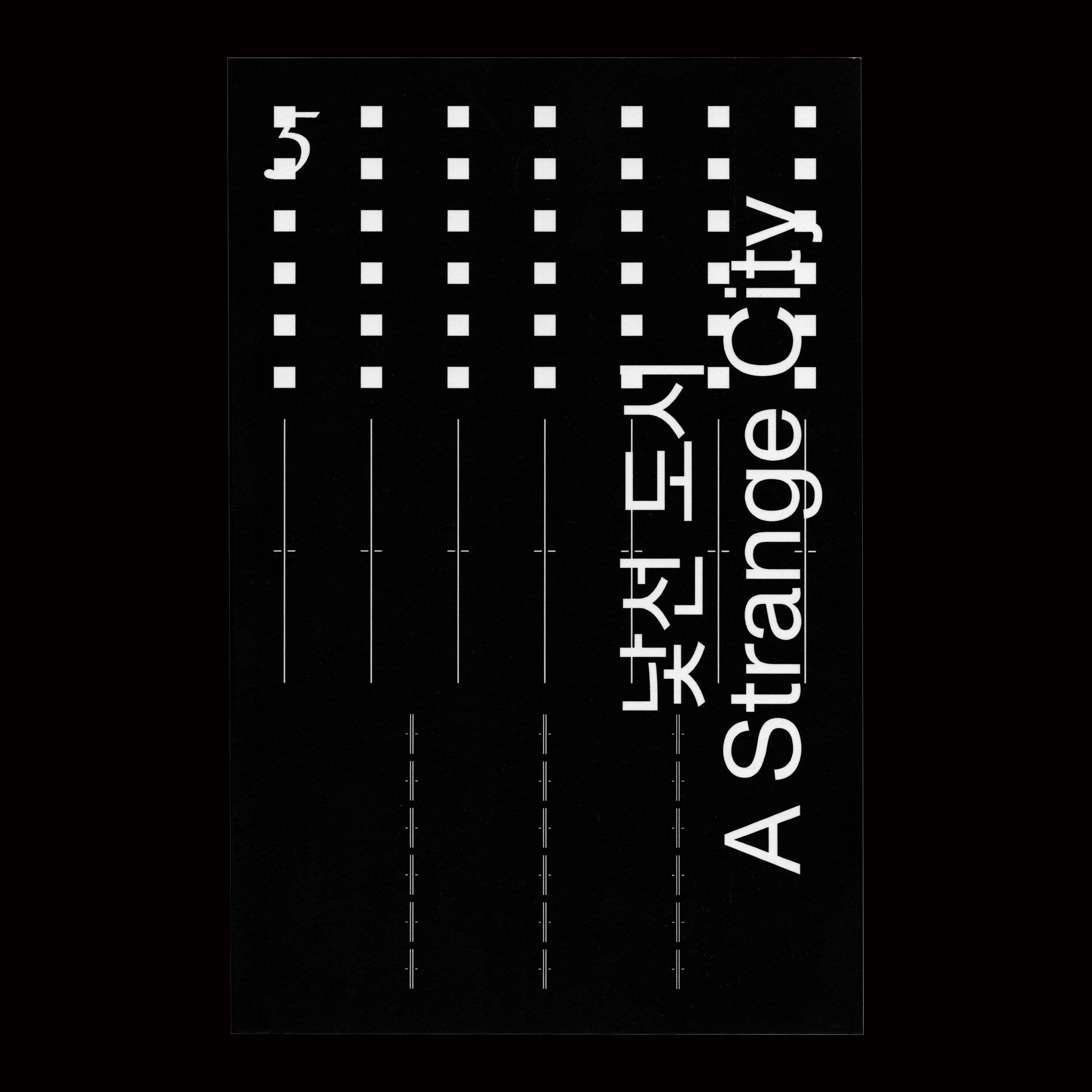
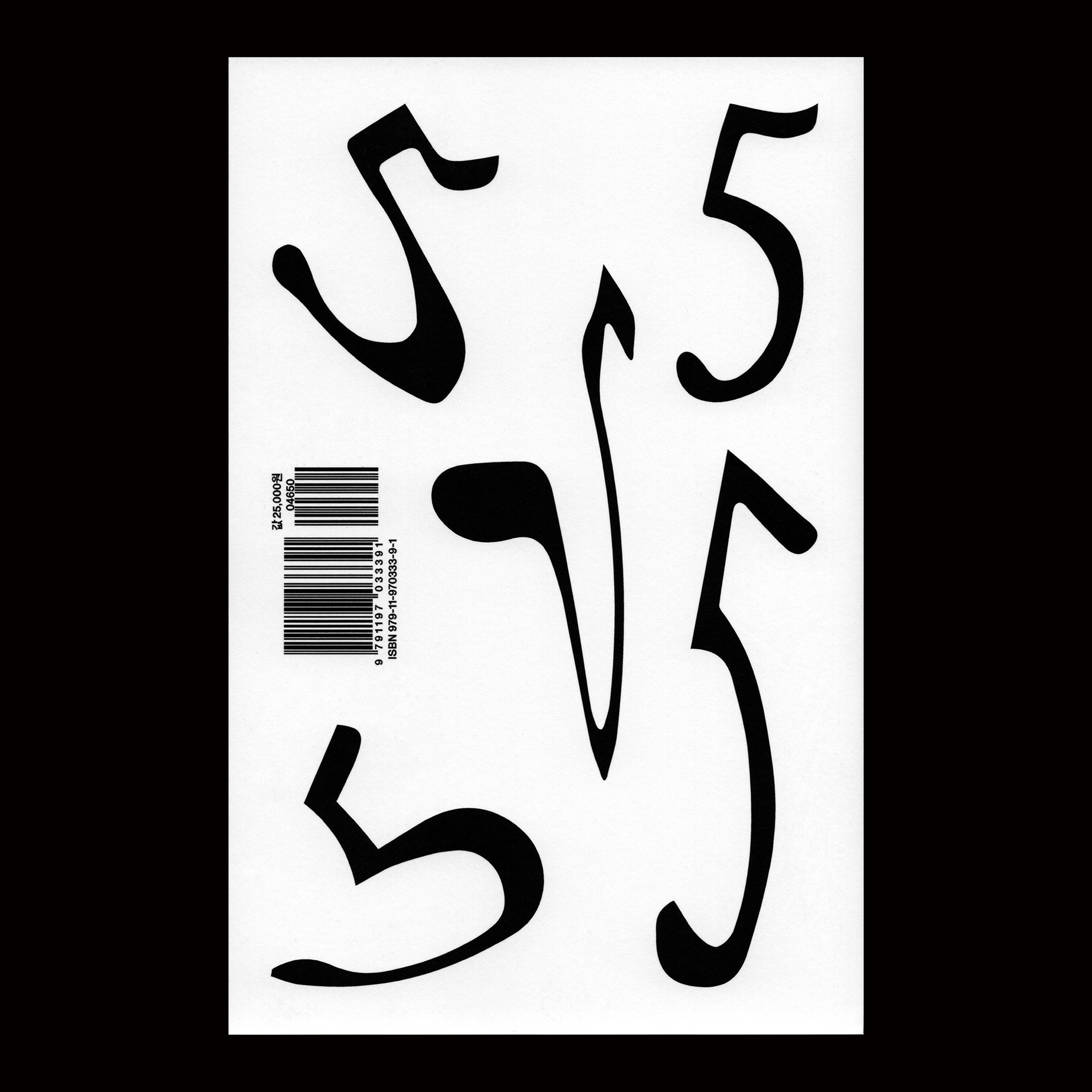
Book Cover (Front / Back)︎︎︎
Participaints
Minjae Kang, Minzi Kim, Yeji Kim, Joonseo Kim, Hajun Kim, Jaeryung Roh, Doyeon Park, Bogeun Park, May Song, Gaeul Um, Hansol Lee, Hyerim Lee, Hyerim Lee, Yuyeon Choi
In Walt Disney's animated film Aladdin, the magical carpet comes to life, making viewers perceive it as a character. It performs tasks such as connecting Aladdin and Princess Jasmine to love each other or bringing Aladdin back to defeat Jafar, but how can we relate to characters when we see a flat carpet with no eyes or nose? Perhaps we can view everyday objects like trash bags in front of telephone poles in a similar way. The fifth A Stranger City begins with this question of "living," or "life."
Fourteen participants explore this question by breaking away from the conventional connection between life and the body, offering various answers through their experiences and memories. For example, interesting interpretations can be made while looking at the graffiti drawn on the shutter without permission, like the concerns of a self-employed acquaintance who came to mind while looking at the leaflet of the telephone pole, and the affection for cherished old things. At first glance, these sentences, which seem to be difficult to connect with life, are very personal and metaphorical. However, this can be a real work that makes participants think and prompt about the subject from various angles and at the same time contains their thoughts and voices.
The workshop proposes two main work processes. The first is the 'silver milk system'. This is the 'axis' created based on the various layers of the subject. Therefore, the work will be transformed into various forms. In 2005, American designer Peter Cho experimented with an intuitive relationship between sound and form in his project 'TAKELUMA'. A bent line conveys the nuances of a word, and a connected line soon conveys the nuances of a sentence. Referring to and applying his experiment, an intuitive form (named ‘metaphoric form') is first planned for both endpoints (topic) of the axis. After the basic form that is primarily visualized moves from the center to the left and right, and changes according to the feeling and impression of the 'metaphoric form' at both ends. In addition, there is an infinite 'between' among each representative point 'A, B, and C,’ allowing the potential for endless creation. Participants organize a series of 'change systems' from one axis, which reminds them of the evolutionary system of living things (such as ‘Caminalcules') published by 'Joseph H. Carmine' in the early 1960s).
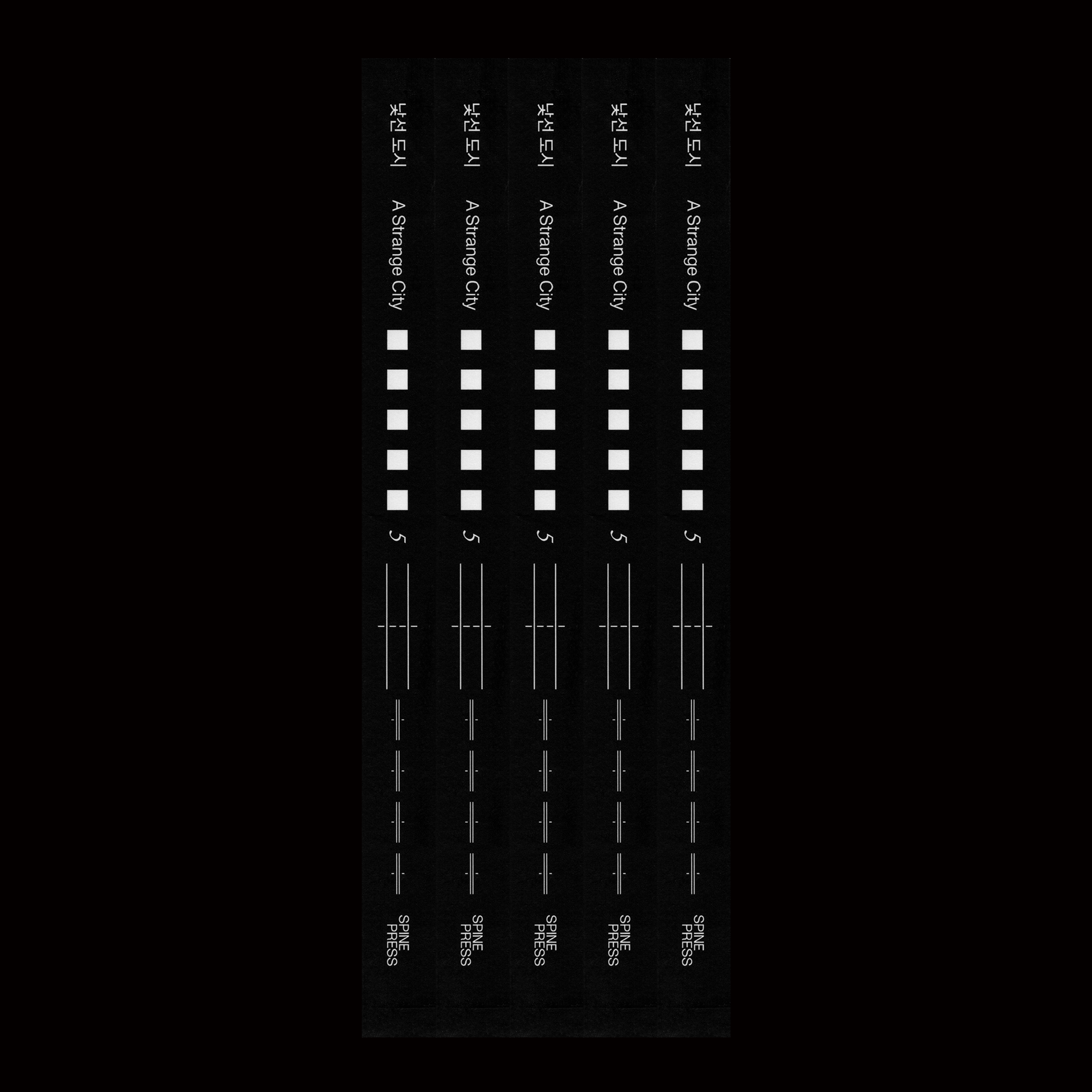
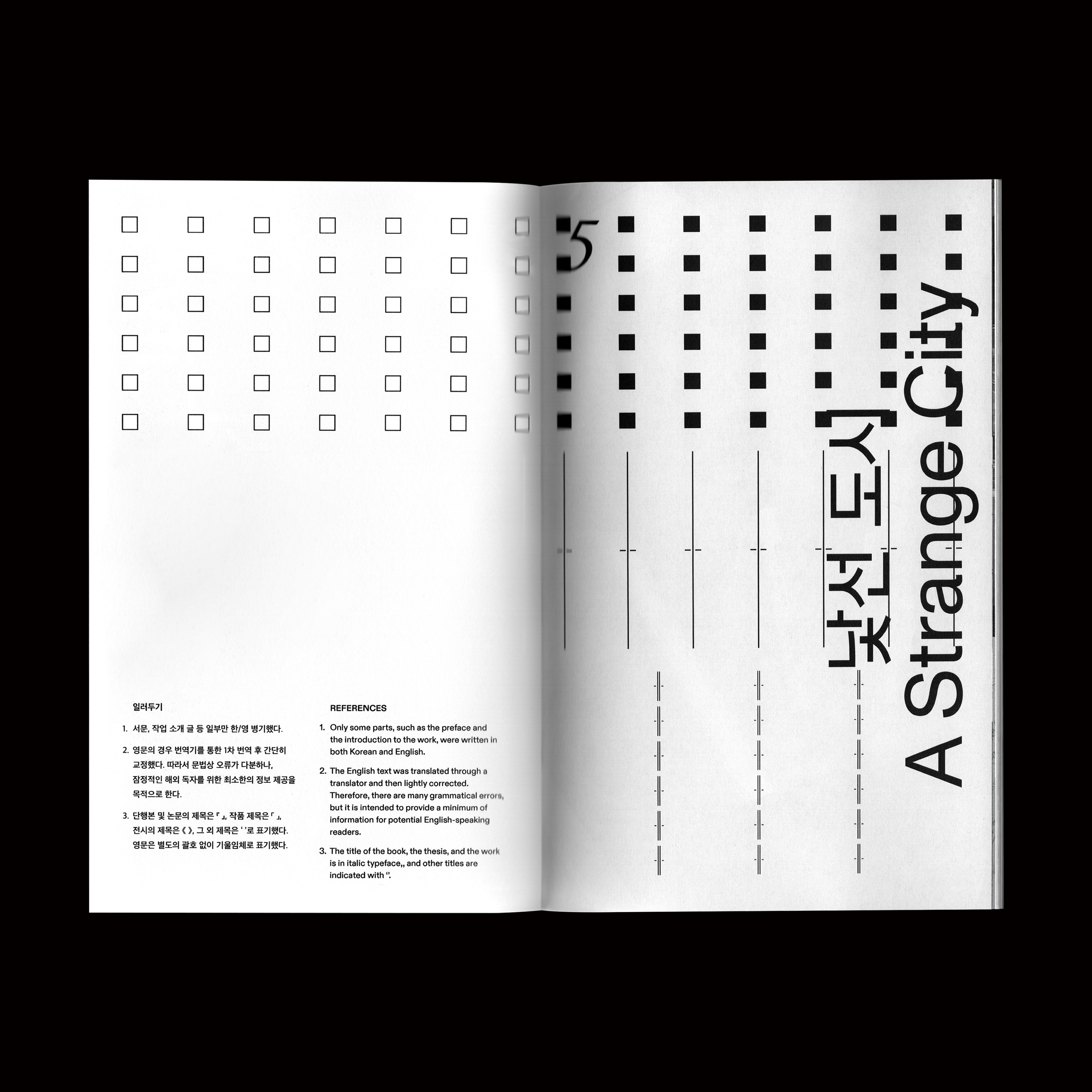
Images︎︎︎
Spine, Body
Secondly, participants are encouraged to step away from their usual tools and methods. Even without unconsciously turning on familiar programs, the starting point of the work can be elusive, and the final destination unpredictable. This difficulty demands fierce consideration of the most appropriate means to express the subject. As a result, the participants performed the process of holding a needle and thread instead of a mouse, sewing the fabric, applying paint to the surface of the object, the mixing and kneading sand and slime. The images produced through these materials are far removed from familiar iconography.
Over a short period of about five weeks, subjects in the flat photos, which were taken while contemplating the subjects, were made to live and move in their own way. We tried to evolve it on a certain system. Without stopping here, it went one step further and combined the results of different evolutions to create variants. But most importantly, it is to continue to make us imagine the next, that is, to suggest the 'infinite possibilities' that each content guarantees. This method encourages us to find the 'magic carpet' around us. Stores that are repeatedly created and disappeared, various roads through the city, and roads that are repeatedly erased and painted on old signs, etc. Can you see the movement of life being reborn?
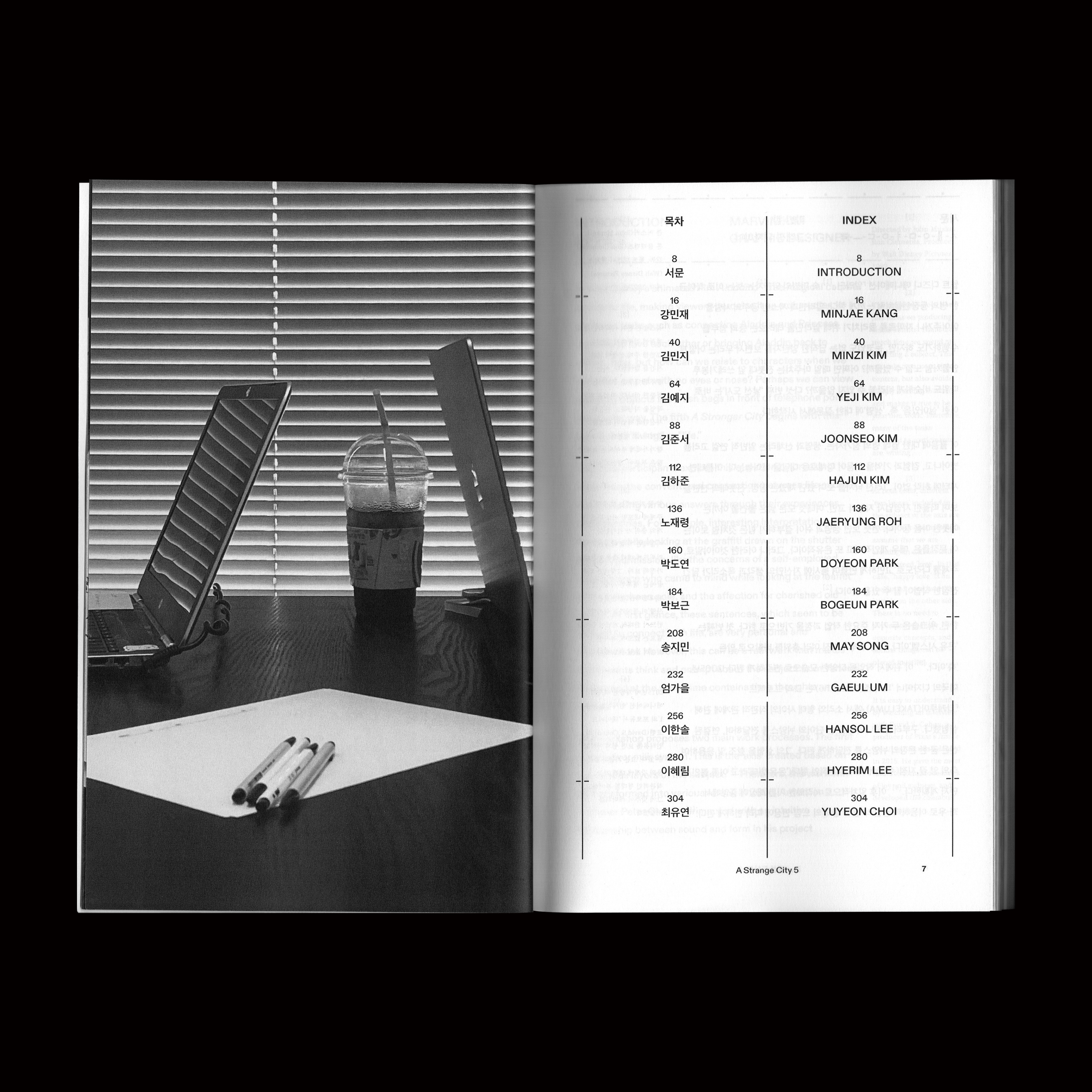
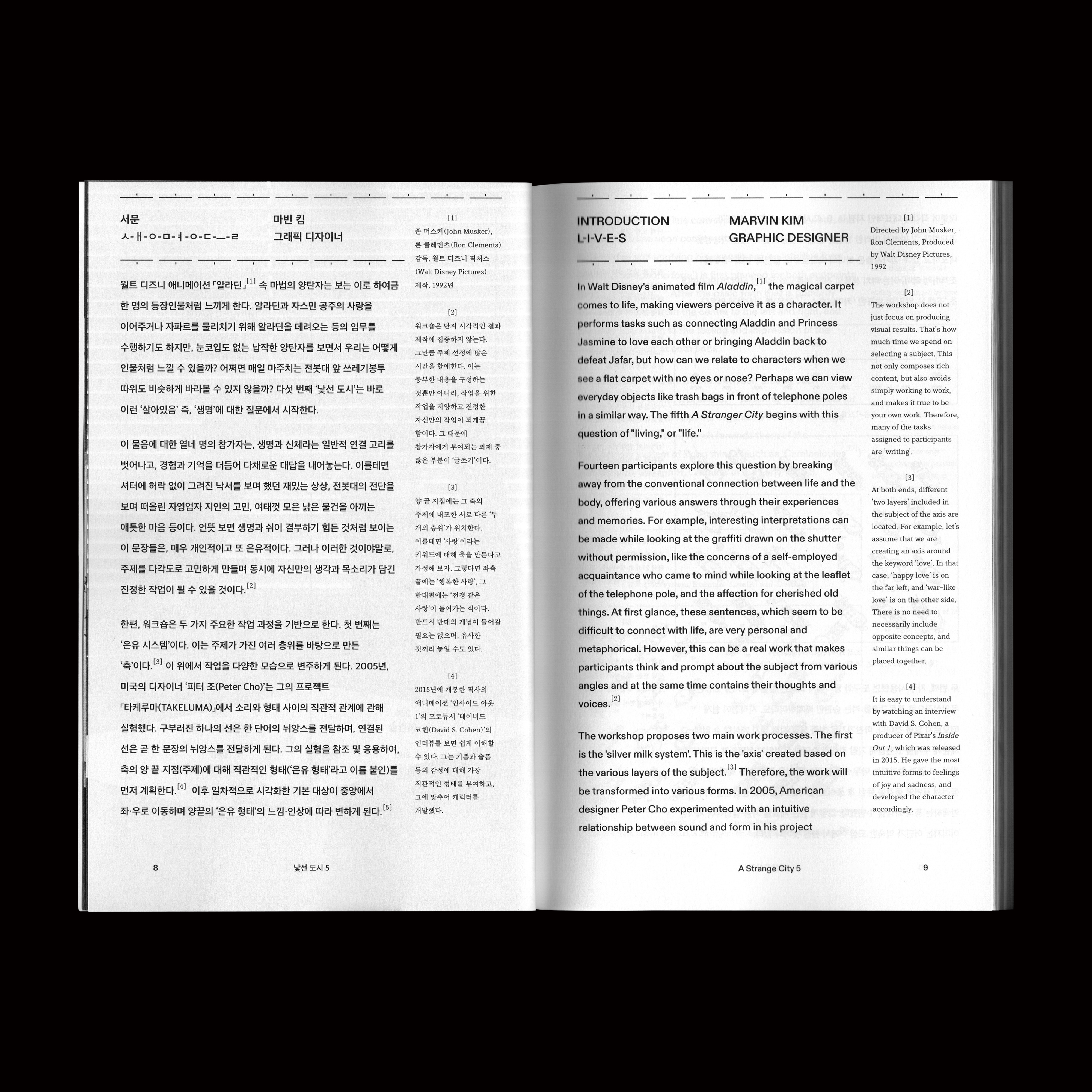

Images︎︎︎
Body (Index, Introduction, Credit)
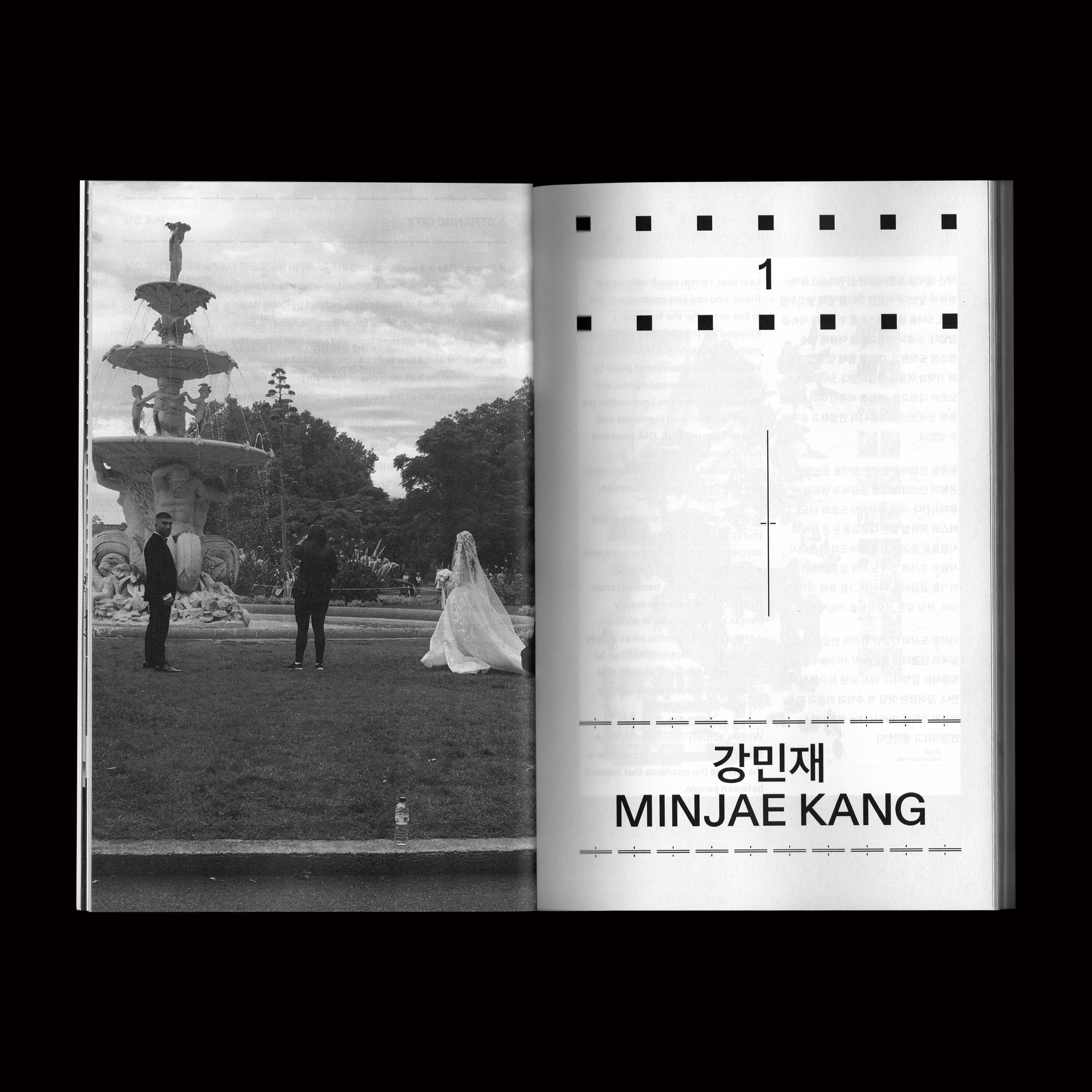
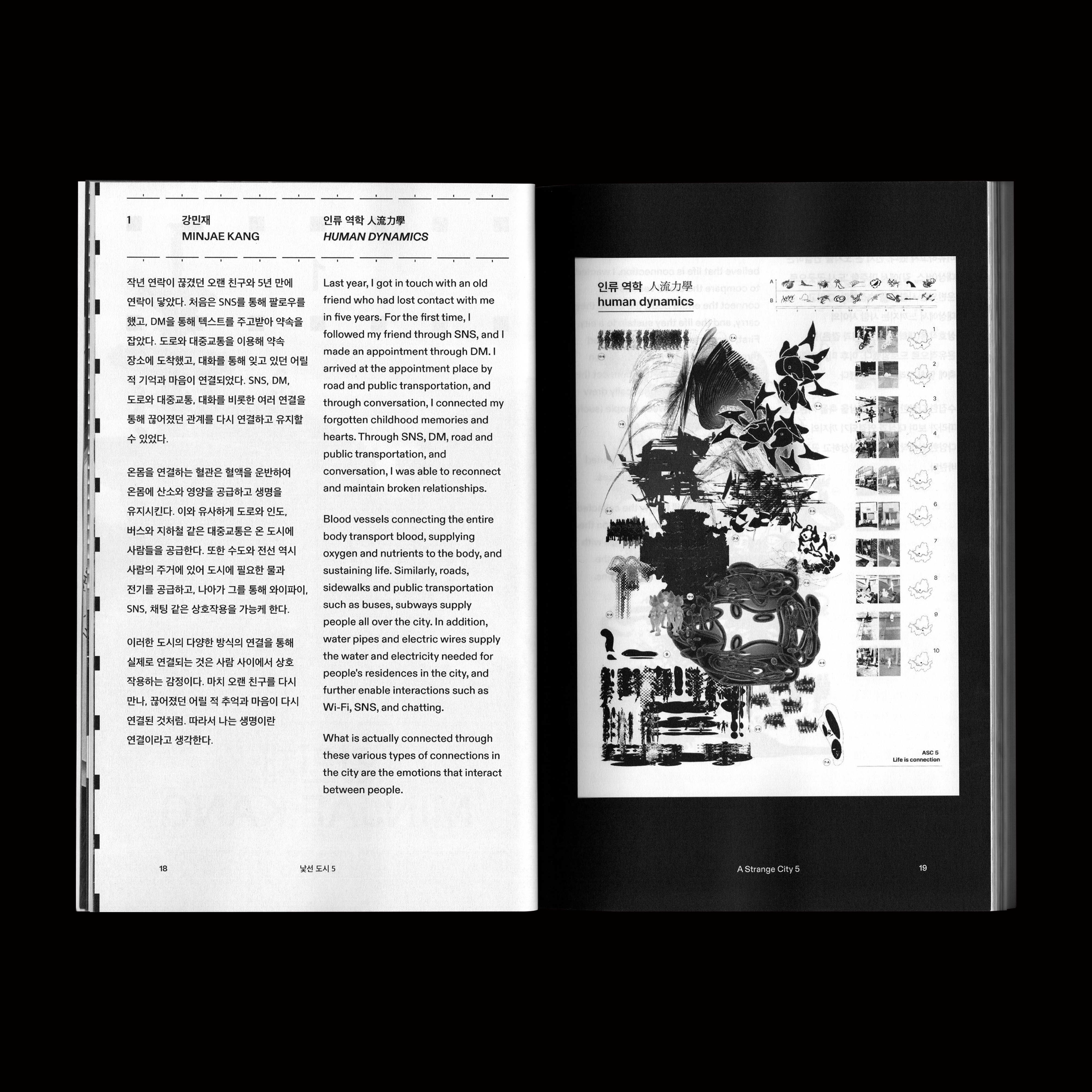
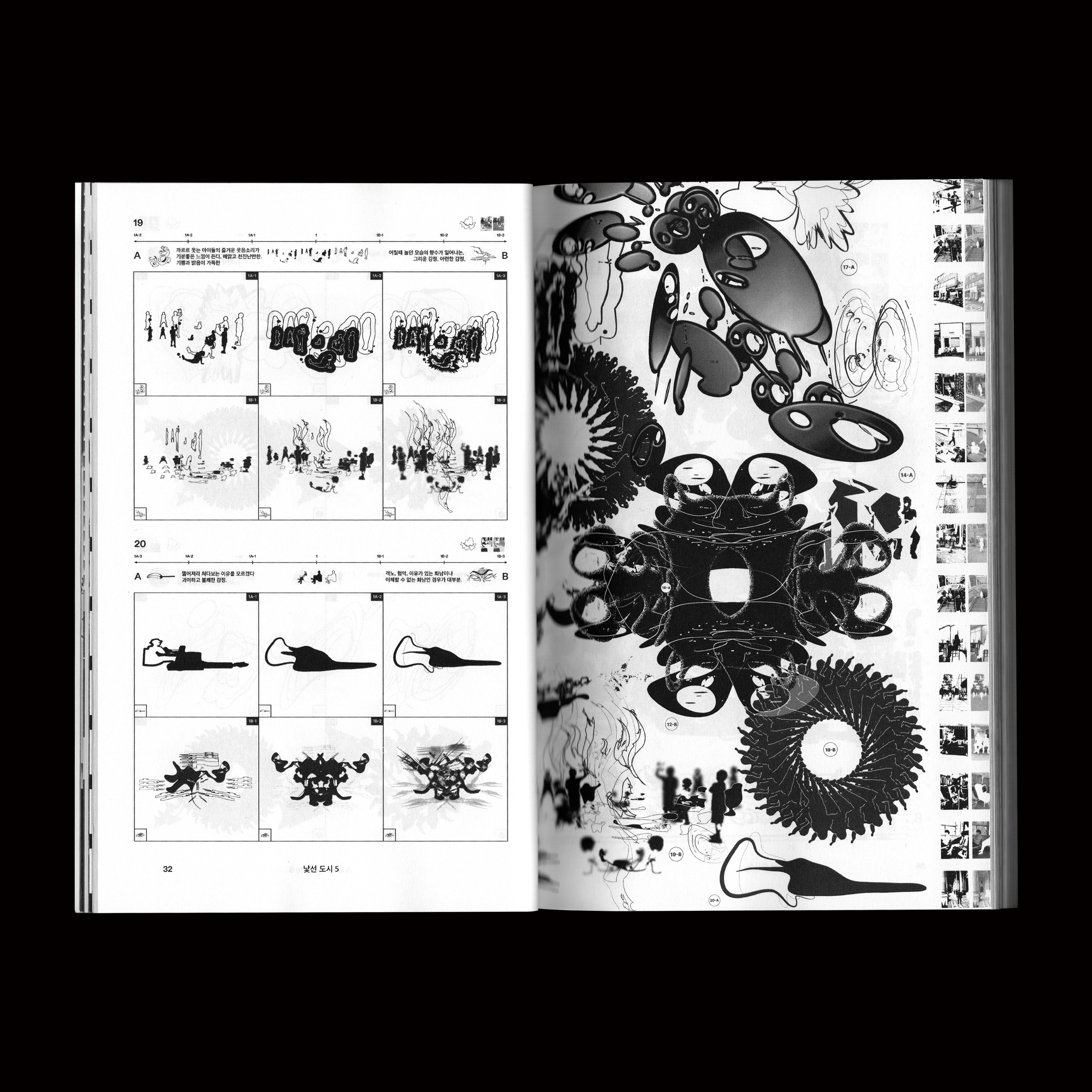
Images︎︎︎
Body (Minjae Kang, Human Dynamics)
MINJAE KANG
Last year, I got in touch with an old friend who had lost contact with me in five years. For the first time, I followed my friend through SNS, and I made an appointment through DM. I arrived at the appointment place by road and public transportation, and through conversation, I connected my forgotten childhood memories and hearts. Through SNS, DM, road and public transportation, and conversation, I was able to reconnect and maintain broken relationships. Blood vessels connecting the entire body transport blood, supplying oxygen and nutrients to the body, and sustaining life. Similarly, roads, sidewalks and public transportation such as buses, subways supply people all over the city. In addition, water pipes and electric wires supply the water and electricity needed for people's residences in the city, and further enable interactions such as Wi-Fi, SNS, and chatting.
What is actually connected through these various types of connections in the city are the emotions that interact between people. It's like meeting an old friend again and reconnecting our heart with lost childhood memories. Therefore, I believe that life is connection. I wanted to compare the blood vessels that connect the entire body, the blood they carry, and the life they sustain to a city. First, I collected ‘people transported throughout the city’ encountered on objects (buses, roads) that connect the entire city. And I metaphorically drew the interactions between people (such as conversations, hearts, and emotions) felt in the object. Afterwards, the graphics were varied according to the pre-planned axes. I hope that you will follow the collected shapes of various people based on the axis and imagine and sympathize with the process of connecting with the object and the various interactions.

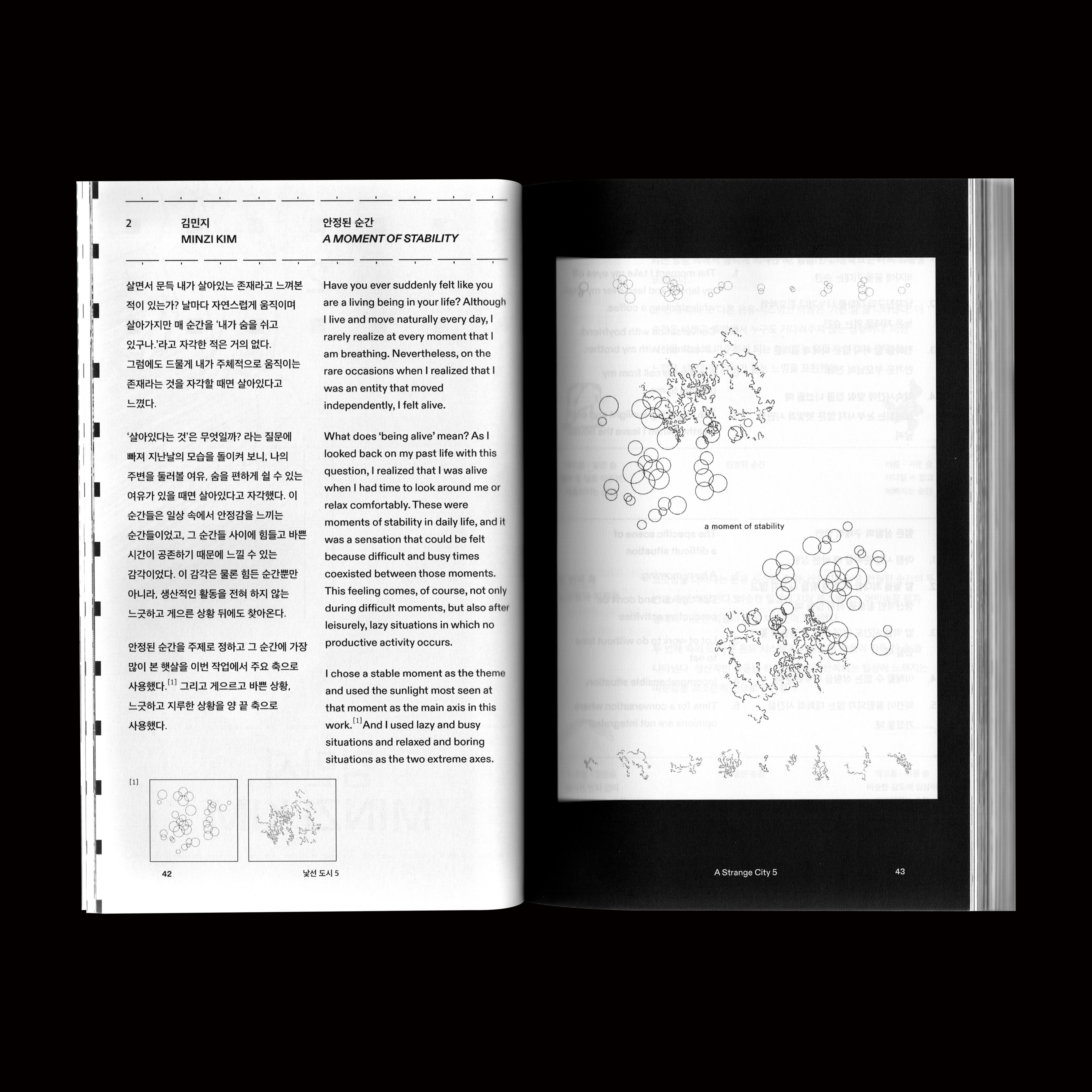

Images︎︎︎
Body (Minzi Kim, A Moment of Stability)
MINZI KIM
Have you ever suddenly felt like you are a living being in your life? Although I live and move naturally every day, I rarely realize at every moment that I am breathing. Nevertheless, on the rare occasions when I realized that I was an entity that moved independently, I felt alive.What does ‘being alive’ mean? As I looked back on my past life with this question, I realized that I was alive when I had time to look around me or relax comfortably.
These were moments of stability in daily life, and it was a sensation that could be felt because difficult and busy times coexisted between those moments. This feeling comes, of course, not only during difficult moments, but also after leisurely, lazy situations in which no productive activity occurs. I chose a stable moment as the theme and used the sunlight most seen at that moment as the main axis in this work. And I used lazy and busy situations and relaxed and boring situations as the two extreme axes.

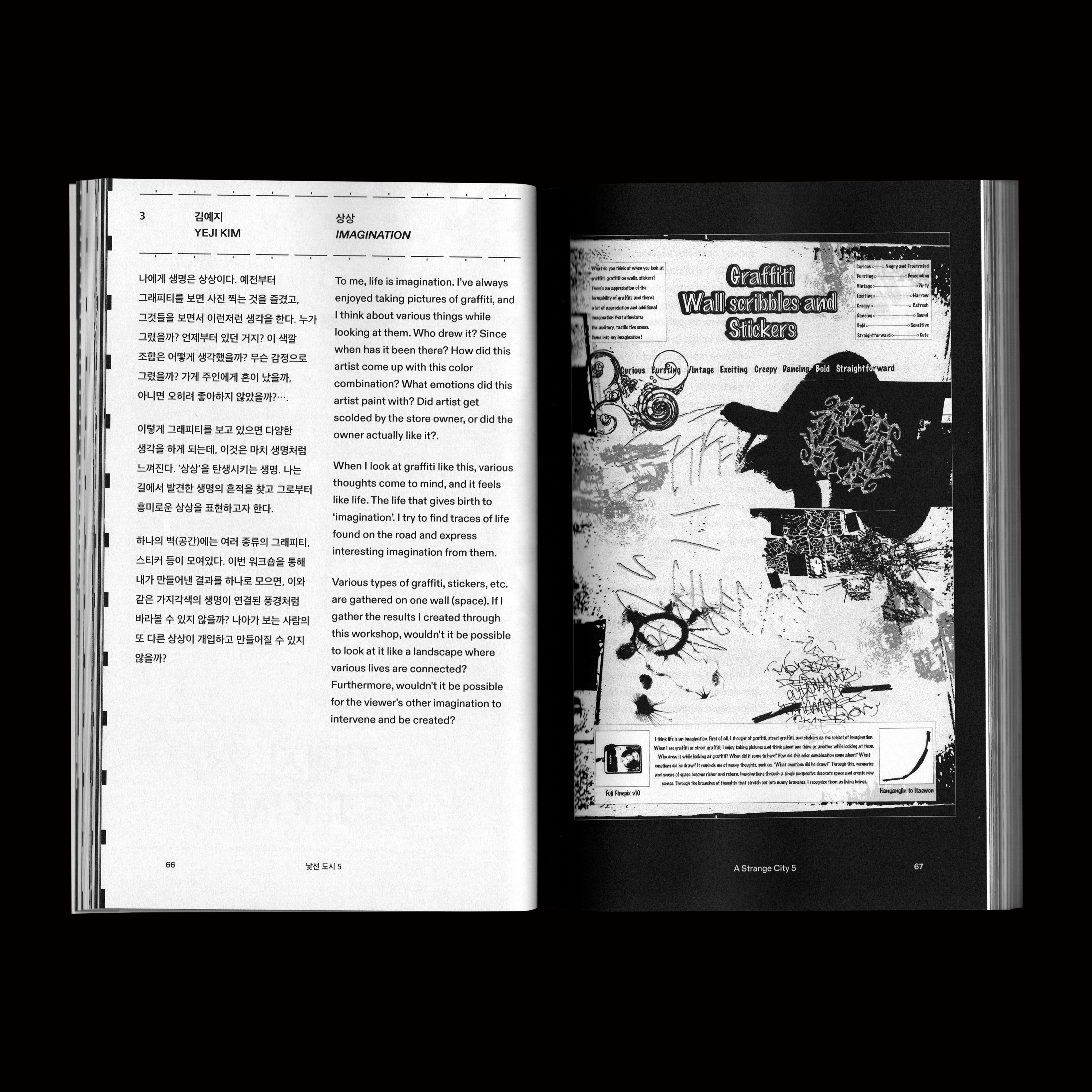
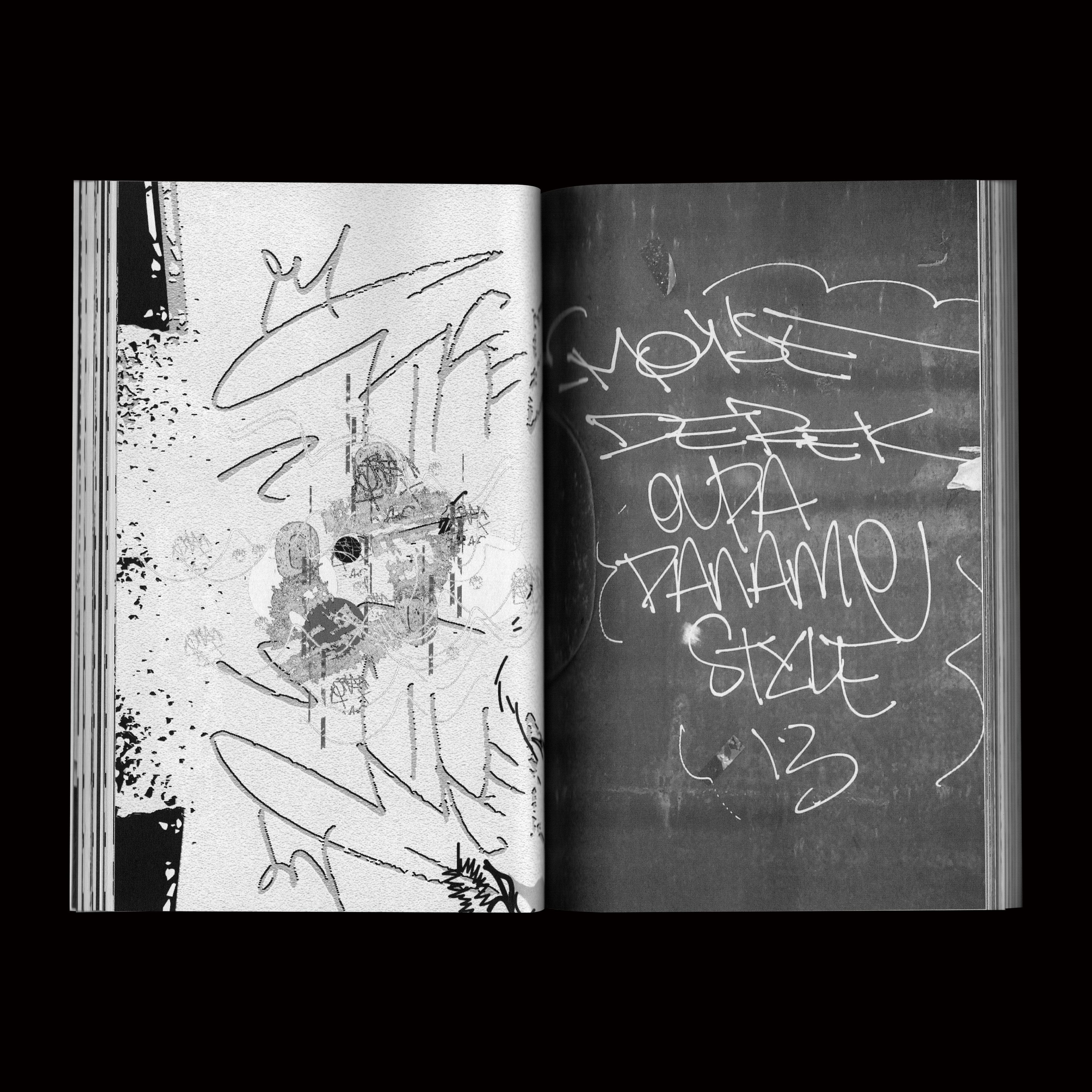
Images︎︎︎
Body (Yeji Kim, Imagination)
YEJI KIM
To me, life is imagination. I've always enjoyed taking pictures of graffiti, and I think about various things while looking at them. Who drew it? Since when has it been there? How did this artist come up with this color combination? What emotions did this artist paint with? Did artist get scolded by the store owner, or did the owner actually like it?.When I look at graffiti like this, various thoughts come to mind, and it feels like life. The life that gives birth to ‘imagination’. I try to find traces of life found on the road and express interesting imagination from them.Various types of graffiti, stickers, etc. are gathered on one wall (space). If I gather the results I created through this workshop, wouldn't it be possible to look at it like a landscape where various lives are connected? Furthermore, wouldn't it be possible for the viewer's other imagination to intervene and be created?

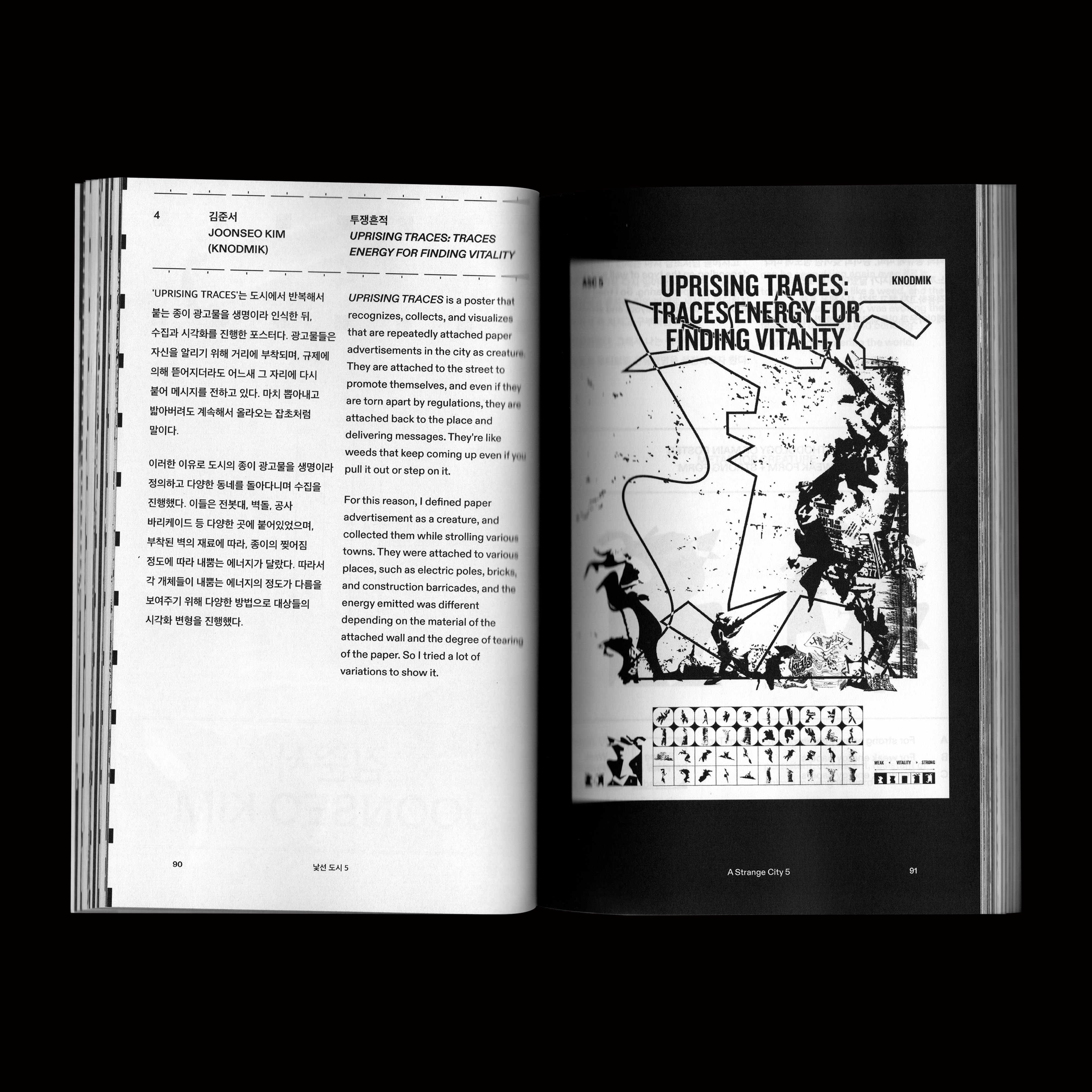
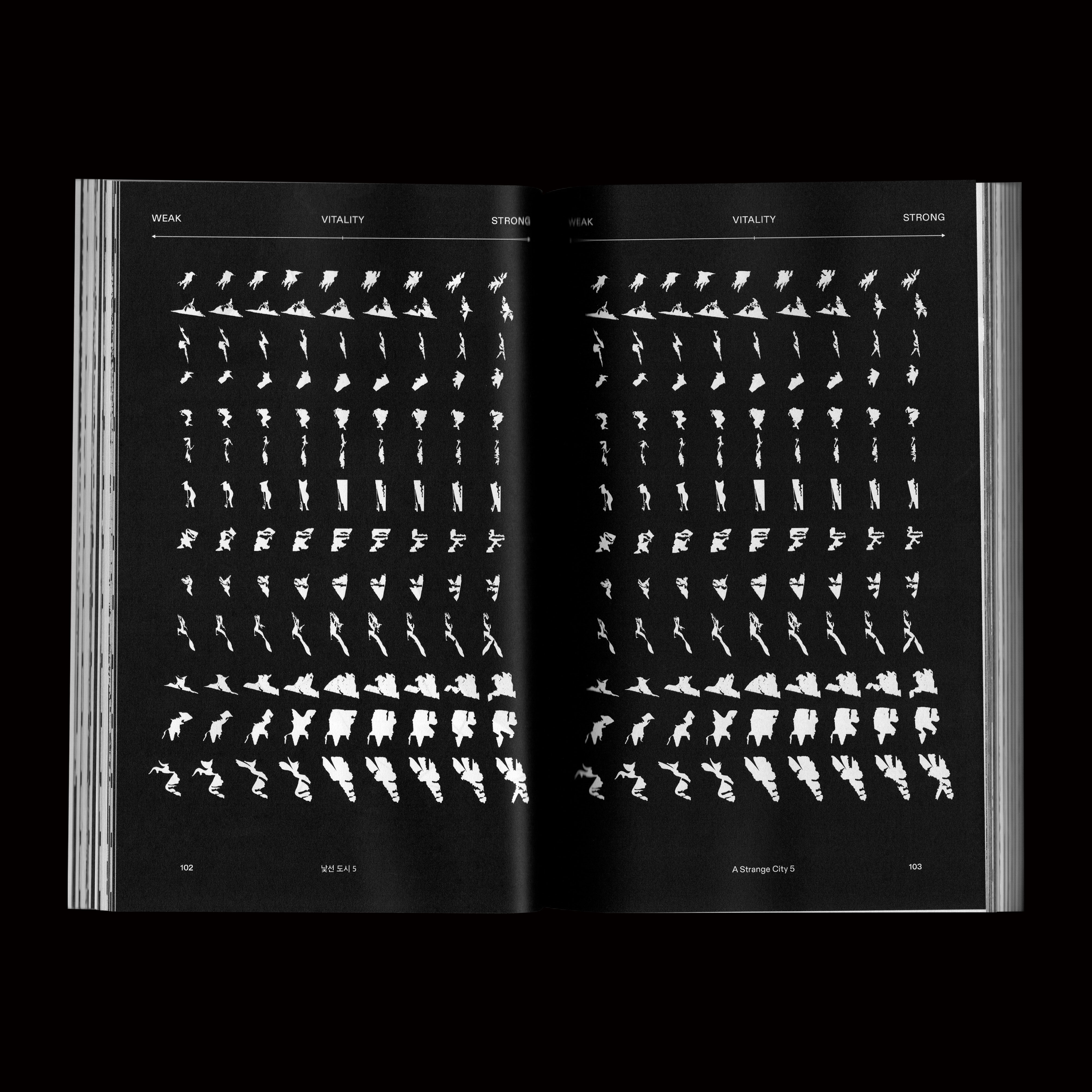
Images︎︎︎
Body (Joonseo Kim, Uprising Traces: Traces Energy for Finding Vitality)
JOONSEO KIM
UPRISING TRACES is a poster that recognizes, collects, and visualizes that are repeatedly attached paper advertisements in the city as creature. They are attached to the street to promote themselves, and even if they are torn apart by regulations, they are attached back to the place and delivering messages. They're like weeds that keep coming up even if you pull it out or step on it. For this reason, I defined paper advertisement as a creature, and collected them while strolling various towns. They were attached to various places, such as electric poles, bricks, and construction barricades, and the energy emitted was different depending on the material of the attached wall and the degree of tearing of the paper. So I tried a lot of variations to show it.


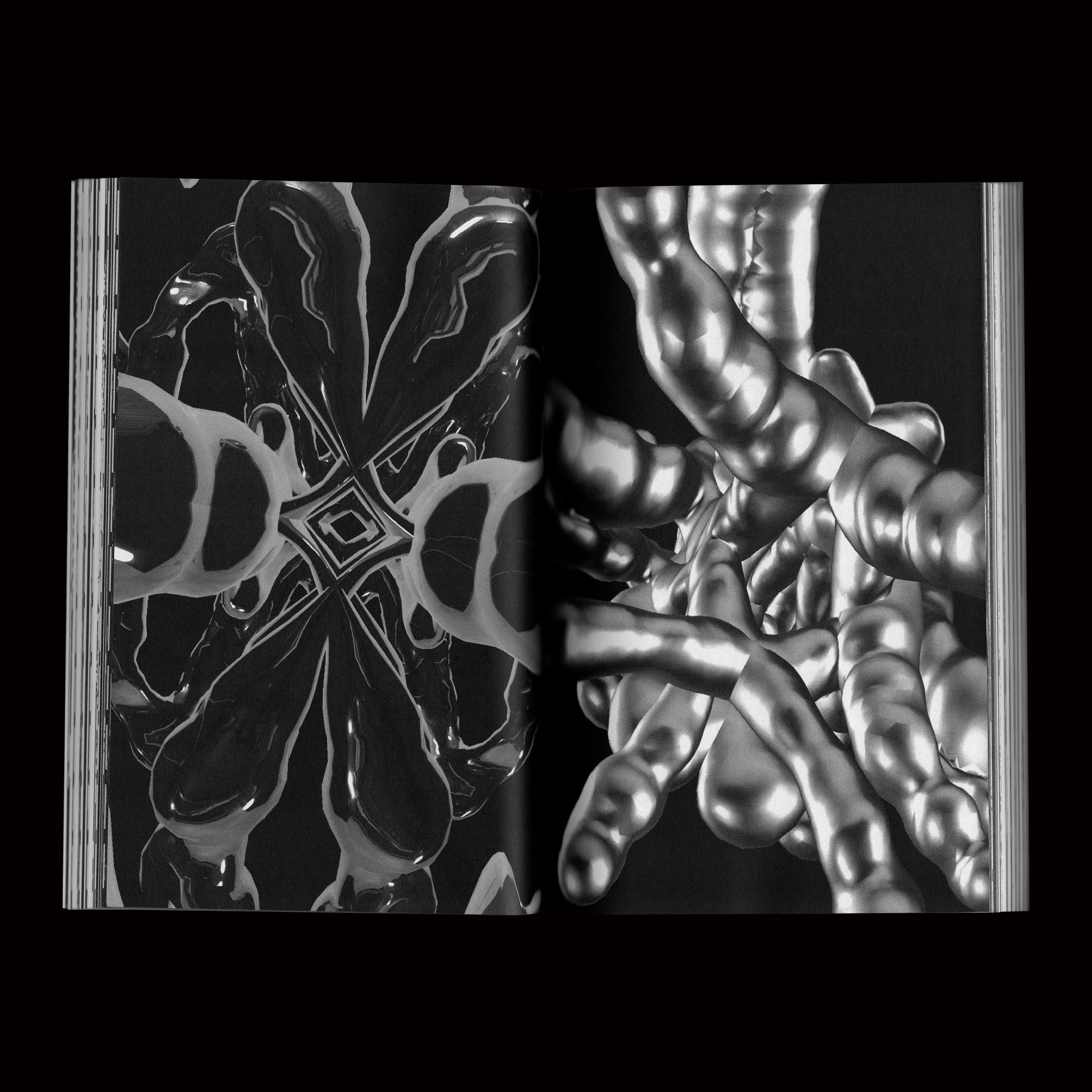
Images︎︎︎
Body (Hajun Kim, The Duality of Life)
HAJUN KIM
I enjoy taking walks around the Han River Bridge and parks when there are fewer people. Around 2 a.m., as I walk across the nearly deserted Mapo Han River Bridge, I could notice various visual details. What stands out most is not the tranquil Han River or the brightly lit skyscrapers of Yeouido, but rather the safety railing installed between the bridge and its piers. The reason why my attention is drawn to this safety railing is the "No Entry" signs and the incongruous presence of a staircase and cage-like structure.
The design of the safety railing, gives the impression of connecting the Han River to the bridge, while its cage-like form suggests a sense of confinement. The addition of the "No Entry" sign gives me a great curiosity. Actually, the purpose of the safety railing is installed to prevent major casualties in case of a bridge collapse. However, as time passed, the number of people attempting suicide from the Han River Bridge has increased, and trying to jump from safety barriers to avoid being seen while attempting suicide. This coexistence of life and death within a single structure (the railing, the piers, and the bridge) intrigued me. It inspired me to explore and express this duality of existence through a 3D program.
The first aspect is the ‘desire to give up on life.’ Giving up on life literally means ending one’s life by jumping off a bridge or over a safety barrier. To avoid a negative portrayal, I used the keyword ‘liberation.’ I visualized a variety of life forms entering the water (the Han River) from the bridge in 3D to depict this sense of liberation, and I drew inspiration from the stair design of the safety barriers. The second aspect is the ‘desire to preserve life.’ This aspect represents the intention to protect precious life by keeping those who commit suicide within the safety barrier. I used Blender to create an image where the safety barrier resembles a cage, connecting it with the bridge to symbolize the effort to confine and prevent precious life from escaping.
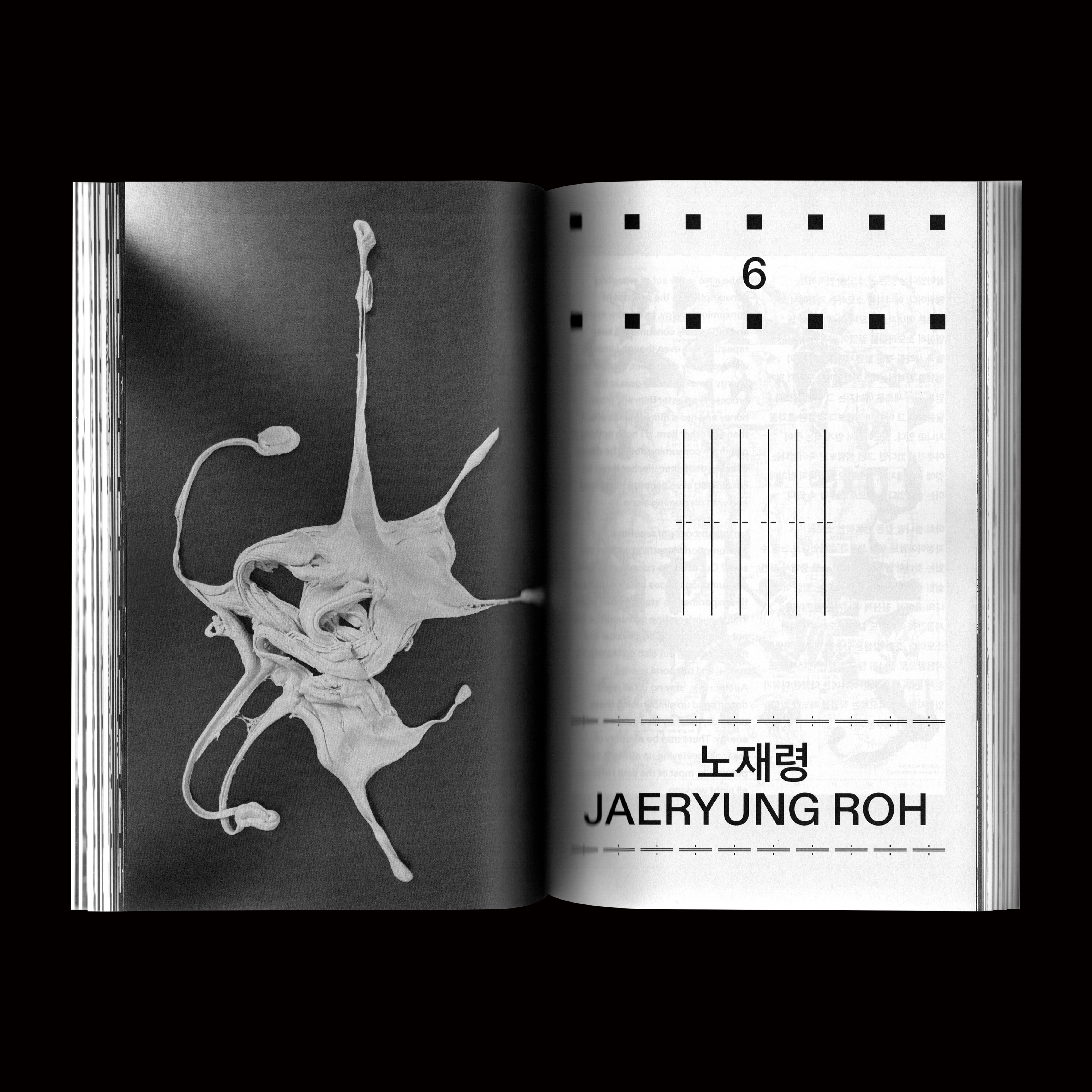
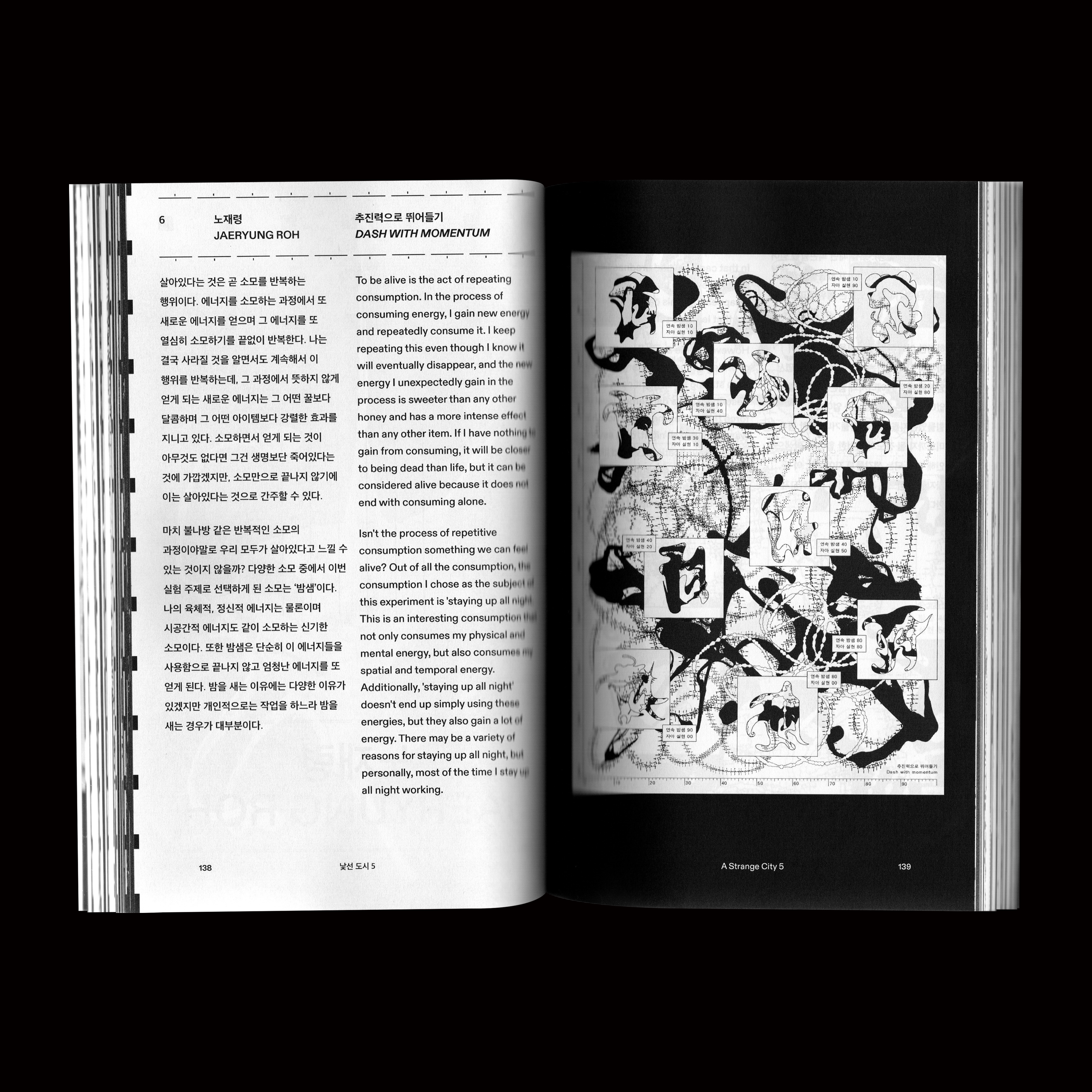

Images︎︎︎
Body (Jaeryung Roh, Dash With Momentum)
JAERYUNG ROH
To be alive is the act of repeating consumption. In the process of consuming energy, I gain new energy and repeatedly consume it. I keep repeating this even though I know it will eventually disappear, and the new energy I unexpectedly gain in the process is sweeter than any other honey and has a more intense effect than any other item. If I have nothing to gain from consuming, it will be closer to being dead than life, but it can be considered alive because it does not end with consuming alone.
Isn't the process of repetitive consumption something we can feel alive? Out of all the consumption, the consumption I chose as the subject of this experiment is 'staying up all night. This is an interesting consumption that not only consumes my physical and mental energy, but also consumes my spatial and temporal energy. Additionally, 'staying up all night' doesn't end up simply using these energies, but they also gain a lot of energy. There may be a variety of reasons for staying up all night, but personally, most of the time I stay up all night working.



Images︎︎︎
Body (Doyeon Park, Proof of Traces)
DOYEON PARK
Life leaves "traces" in any form. Traces are marks that remain after a certain phenomenon or substance has disappeared or passed. Water on the surface of a cup floats down on the desk, crumbs left after eating bread, traces of tape attached and detached, handprints that seem to show movement to open a door, and footprints left on the dirt floor. There are traces that can be easily found in everyday life, but are rarely looked into in depth. I feel their existence and vitality by looking at the traces left in someone has passed.
In this project, I wanted to relieve the grandeur of the desire that humans want to leave and use the traces that naturally remain as evidence to project the meaning of life. I paid attention to the traces that life leaves on the world by existence itself and small actions. Therefore, the 'traces' mentioned here are not grandiose things that appear with effort. It deals with traces and phenomena that may feel trivial, but can be left naturally by anyone.
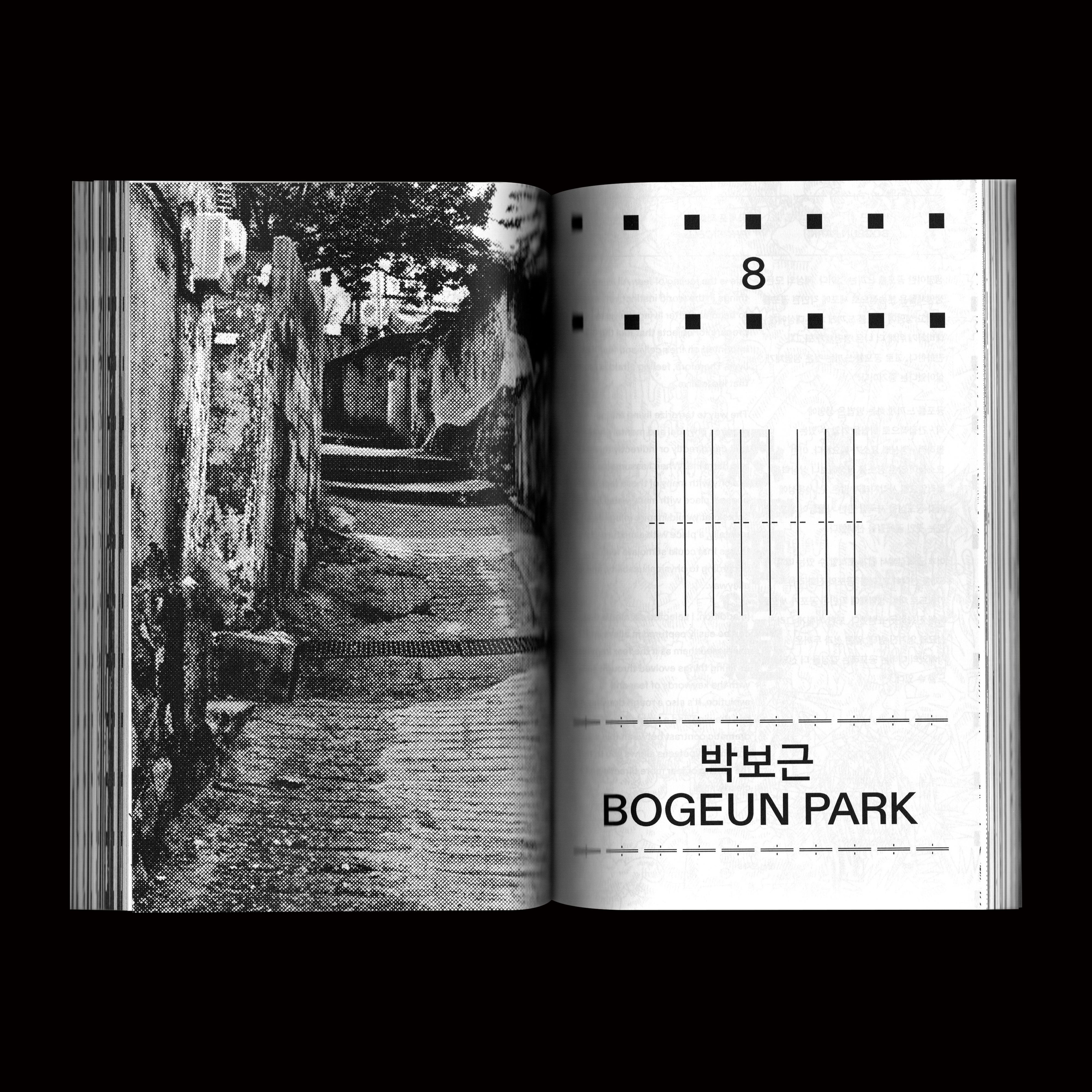
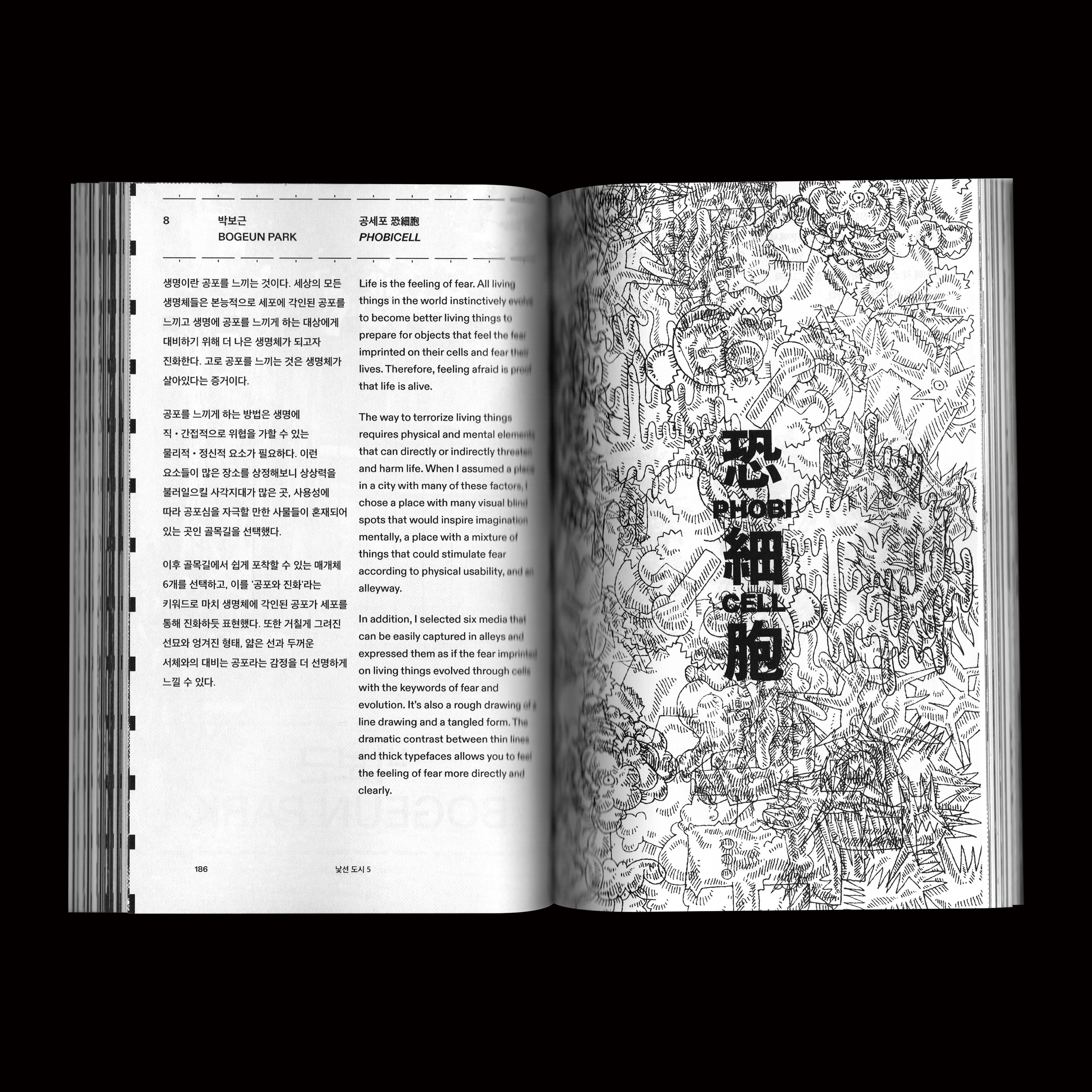

Images︎︎︎
Body (Bogeun Park, Phobicell)
BOGEUN PARK
Life is the feeling of fear. All living things in the world instinctively evolve to become better living things to prepare for objects that feel the fear imprinted on their cells and fear their lives. Therefore, feeling afraid is proof that life is alive. The way to terrorize living things requires physical and mental elements that can directly or indirectly threaten and harm life. When I assumed a place in a city with many of these factors, I chose a place with many visual blind spots that would inspire imagination mentally, a place with a mixture of things that could stimulate fear according to physical usability, and an alleyway.
In addition, I selected six media that can be easily captured in alleys and expressed them as if the fear imprinted on living things evolved through cells with the keywords of fear and evolution. It's also a rough drawing of a line drawing and a tangled form. The dramatic contrast between thin lines and thick typefaces allows you to feel the feeling of fear more directly and clearly.
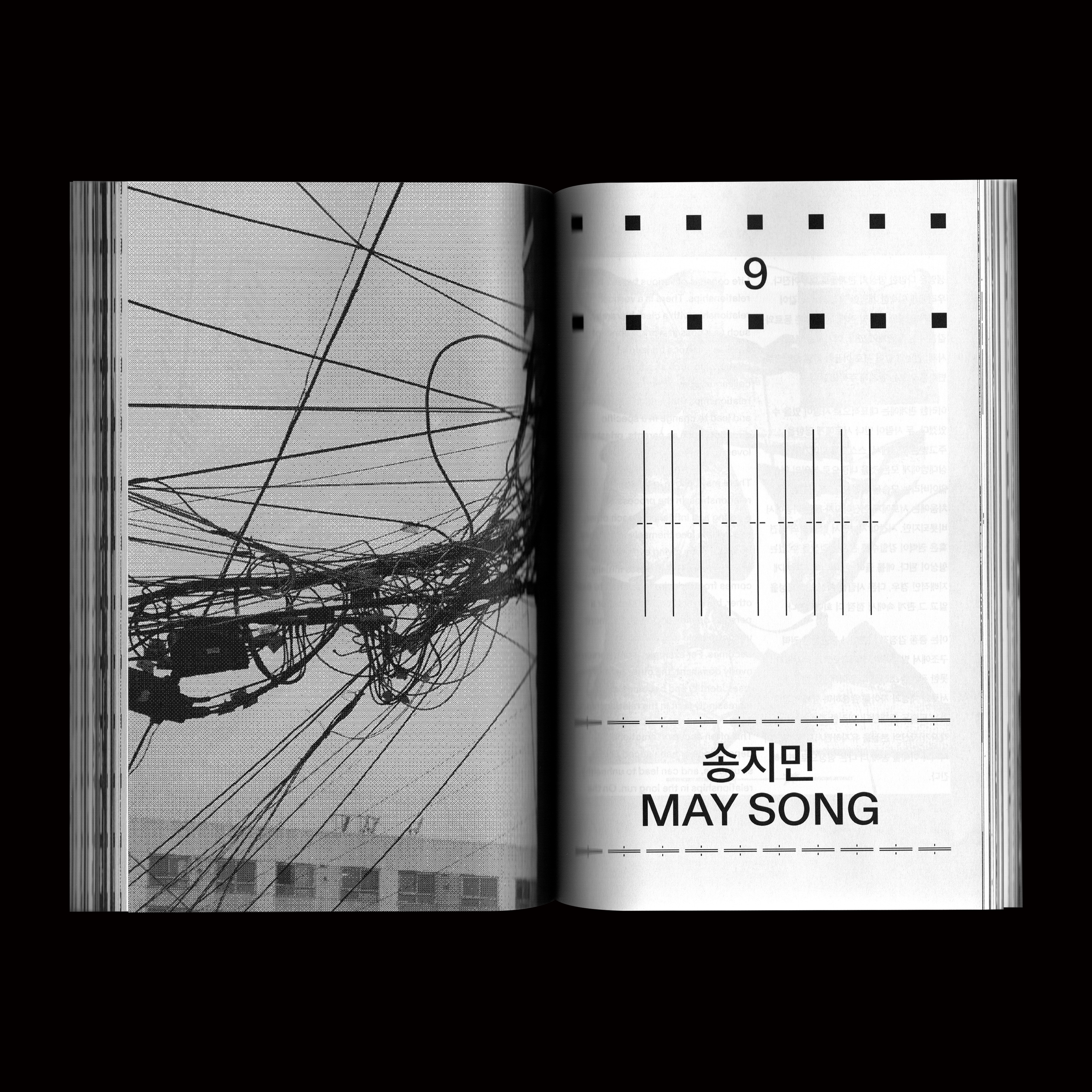


Images︎︎︎
Body (May Song, Attract)
MAY SONG
Life consists of various types of relationships. There is a vertical relationship with a clear hierarchy, such as a boss at work, a concept familiar to us, or a horizontal relationship such as a friend or colleague. I pay attention to relationships that lead to each other and lead to change in a specific direction, such as parents, priests, and lovers. There may be love in these relationships. In the process of meeting and influencing each other, two people lose themselves and lose their image by giving everything to the other person. This process initially comes from a desire to commit to each other, but over time, the stronger a person's opinion or power, the more uncontrollable the relationship becomes. For example, if one person is overly dominant, the other person loses identity and becomes increasingly faint in the relationship.
This often occurs in emotional dependence or unbalanced power structures, and can lead to unhealthy relationships in the long run. On the contrary, there is also a way of growing together with respect for each other's individuality and self In this relationship, each person maintains his or her essence and changes into a better shape through mutual support and understanding. This is accomplished through the process of two people acknowledging and respecting each other's differences and seeking solutions together. In this relationship, individuals enrich the relationship through their own growth and development and have a positive effect on each other. In this way, I collect and observe things in the city center and apply the above dominant change system and respectful change system to find the pattern of change and relationship.
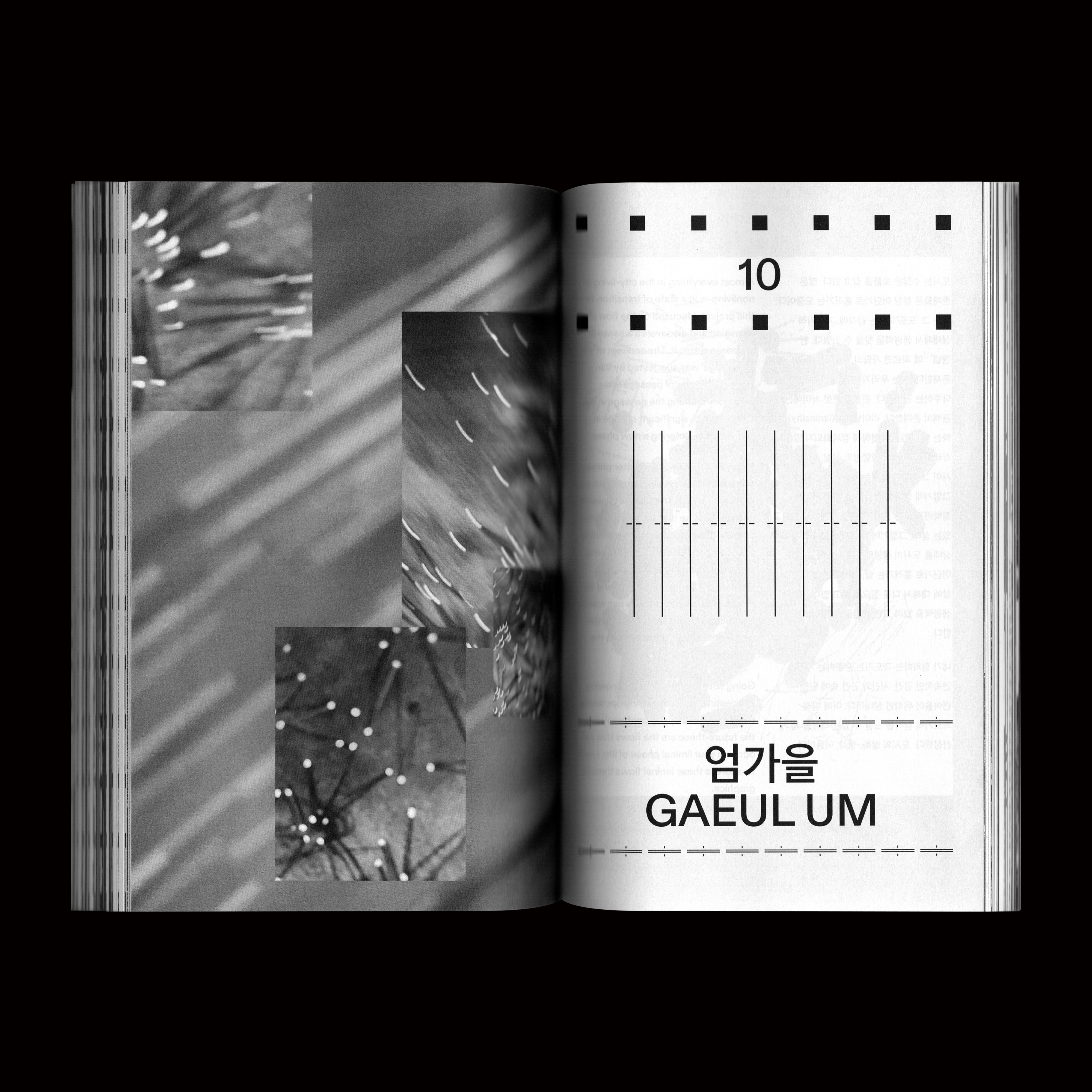
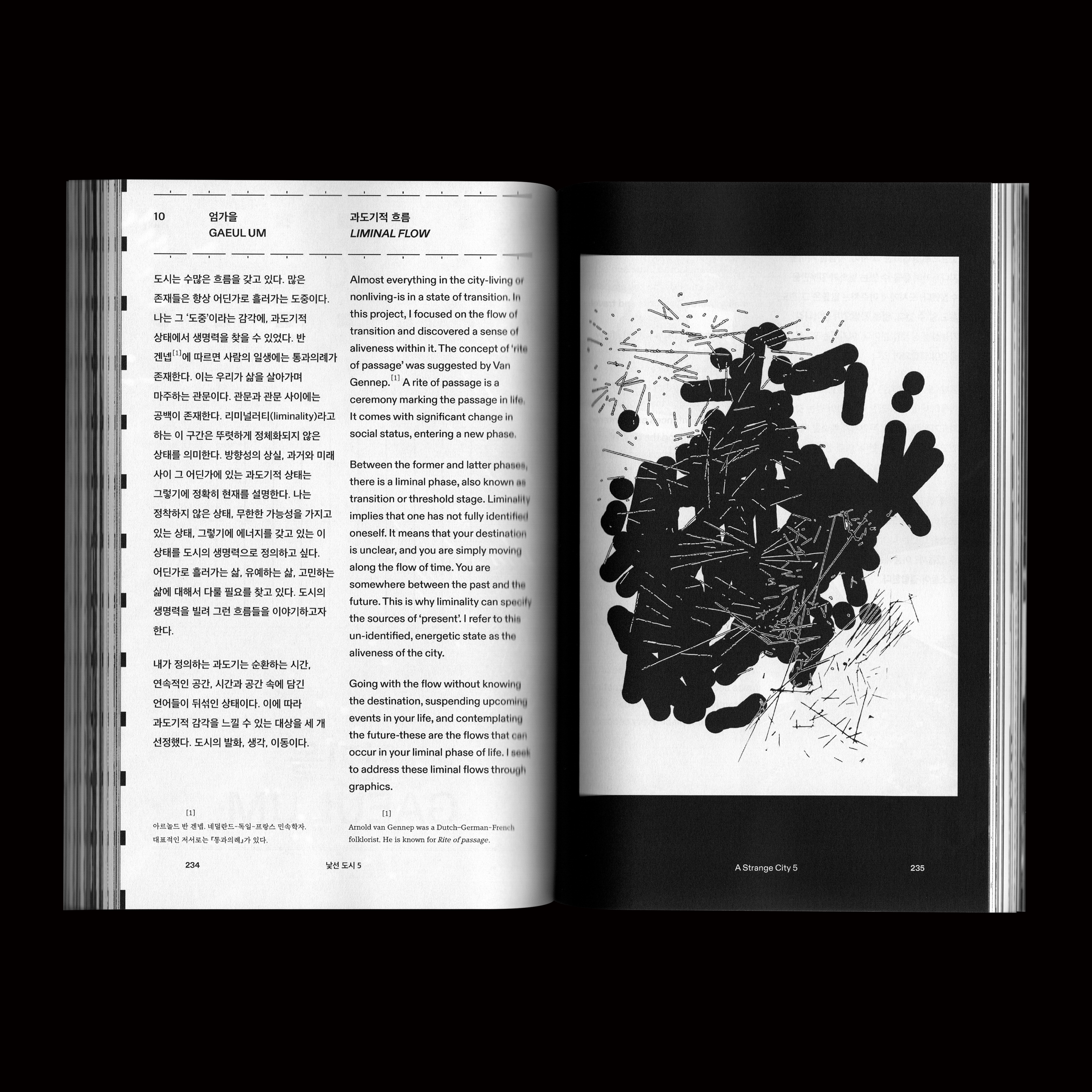
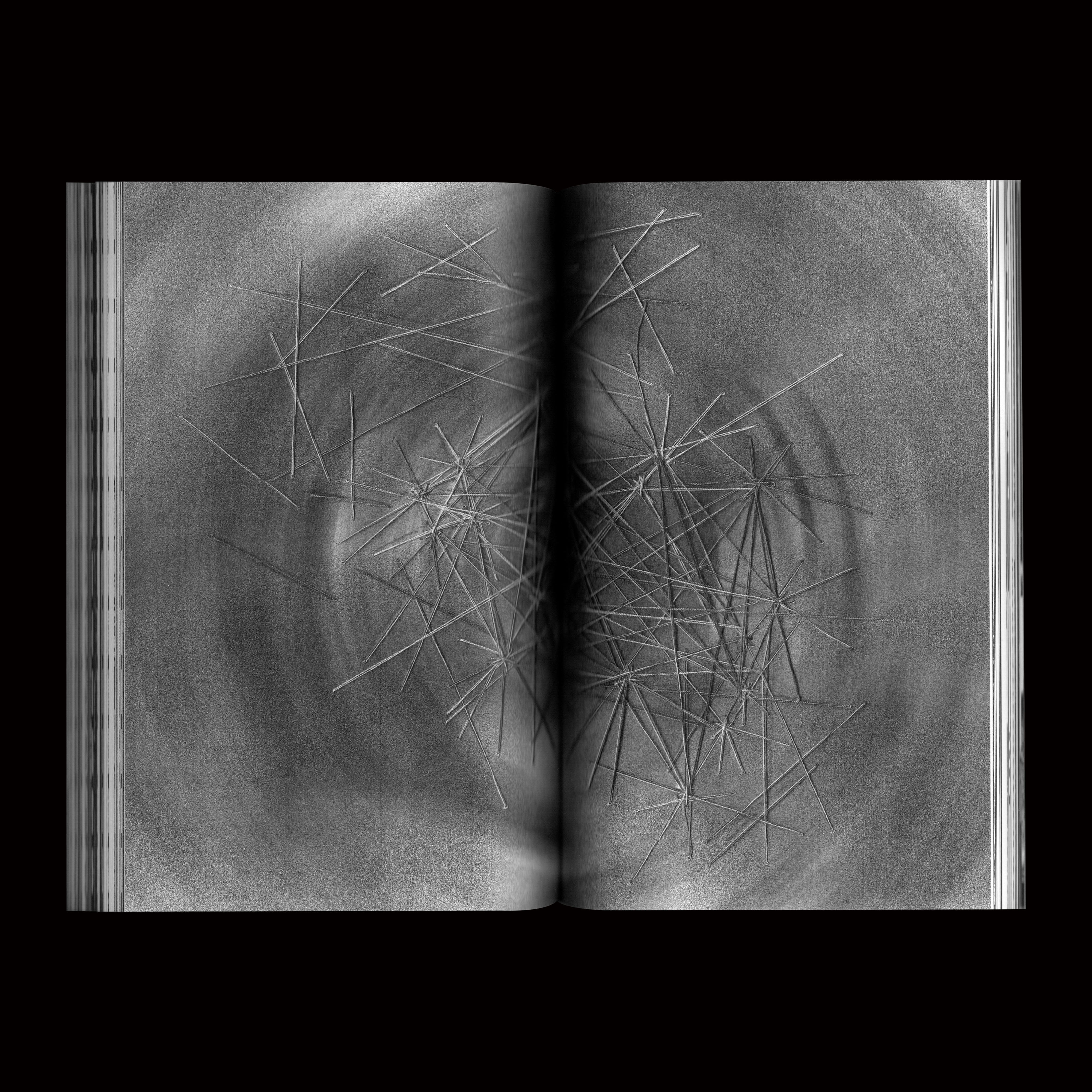
Images︎︎︎
Body (Gaeul Um, Liminal Flow)
GAEUL UM
Almost everything in the city-living or nonliving-is in a state of transition. In this project, I focused on the flow of transition and discovered a sense of aliveness within it. The concept of ‘rite of passage’ was suggested by Van Gennep.[1] A rite of passage is a ceremony marking the passage in life. It comes with significant change in social status, entering a new phase.
Between the former and latter phases, there is a liminal phase, also known as transition or threshold stage. Liminality implies that one has not fully identified oneself. It means that your destination is unclear, and you are simply moving along the flow of time. You are somewhere between the past and the future. This is why liminality can specify the sources of ‘present’. I refer to this un-identified, energetic state as the aliveness of the city.
Going with the flow without knowing the destination, suspending upcoming events in your life, and contemplating the future-these are the flows that can occur in your liminal phase of life. I seek to address these liminal flows through graphics.
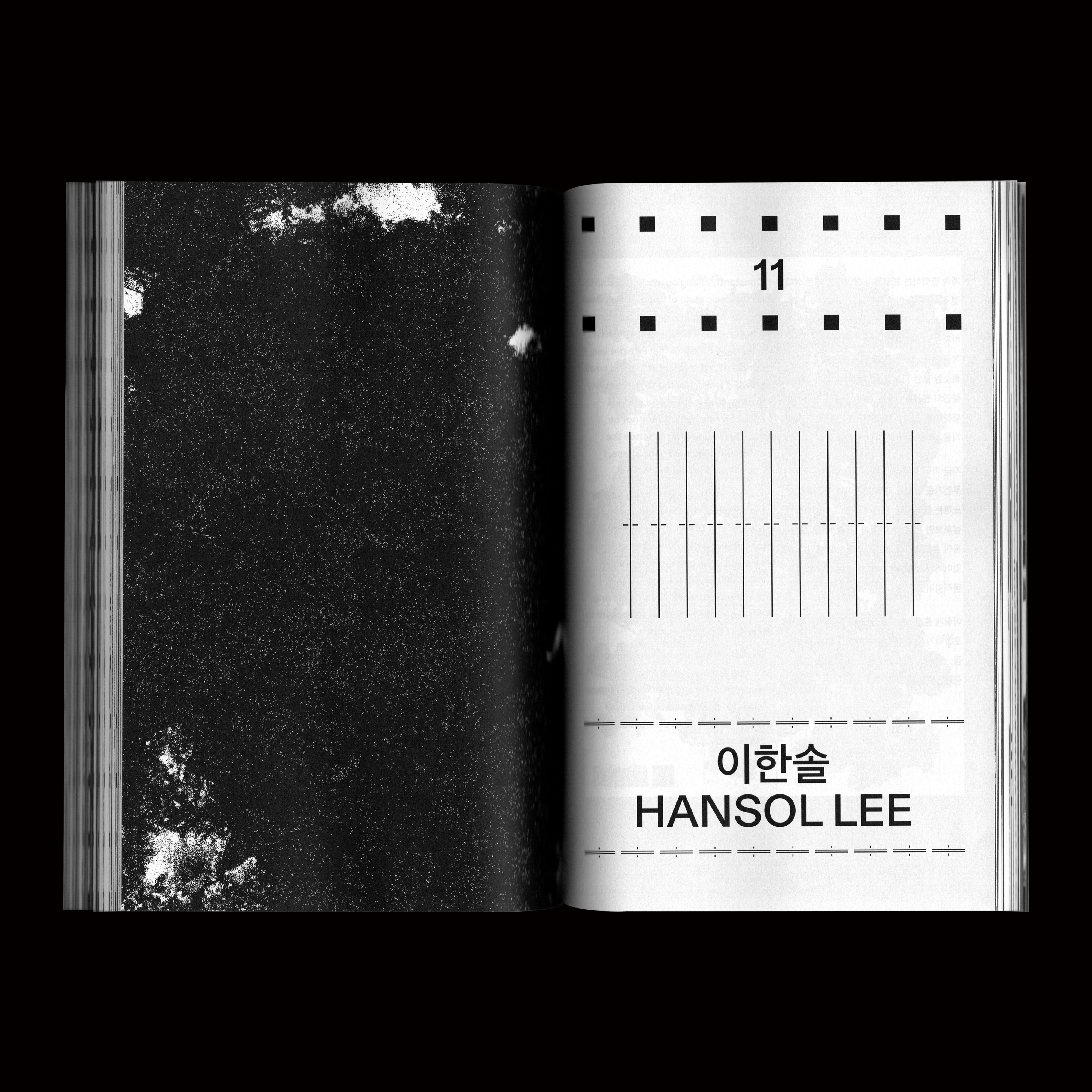
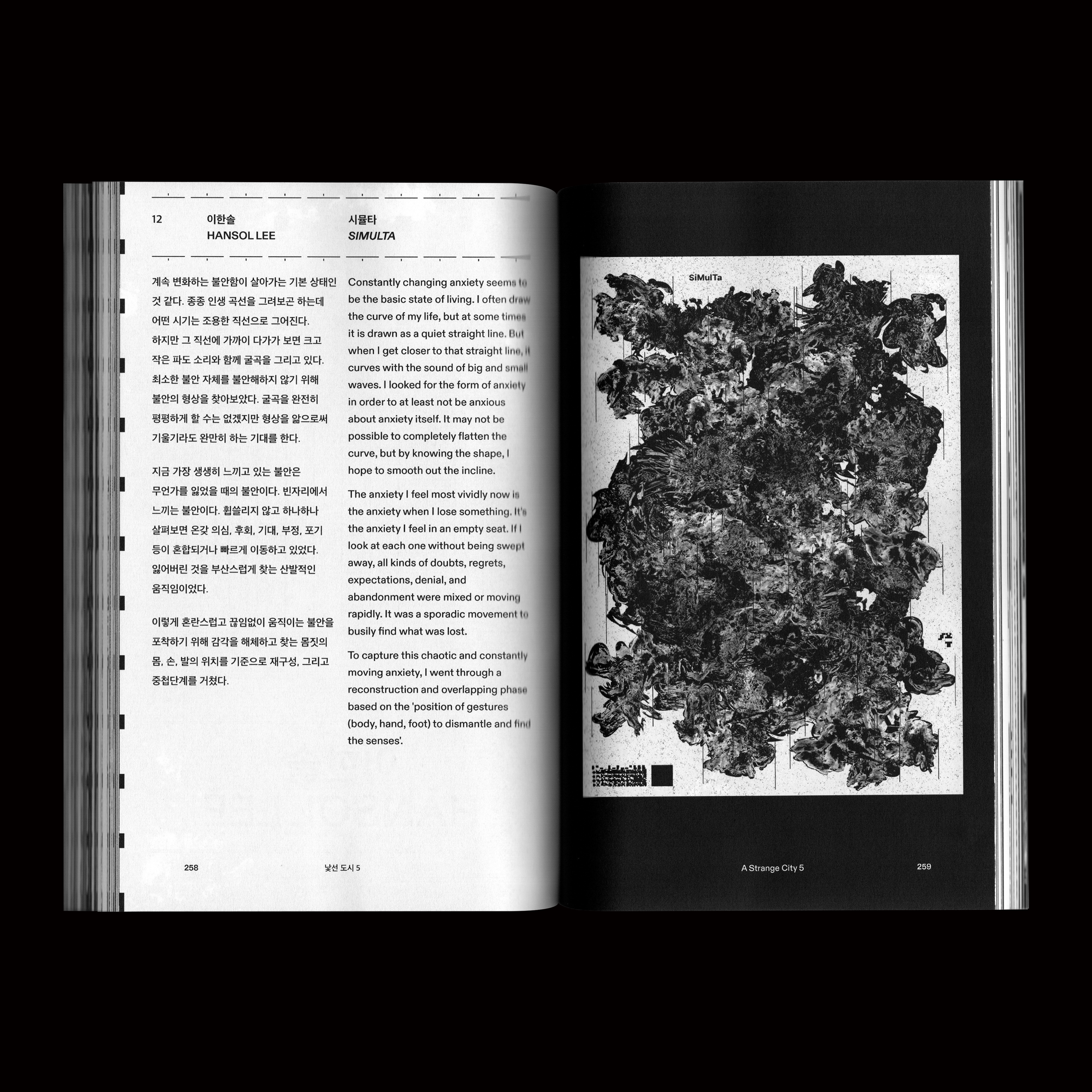
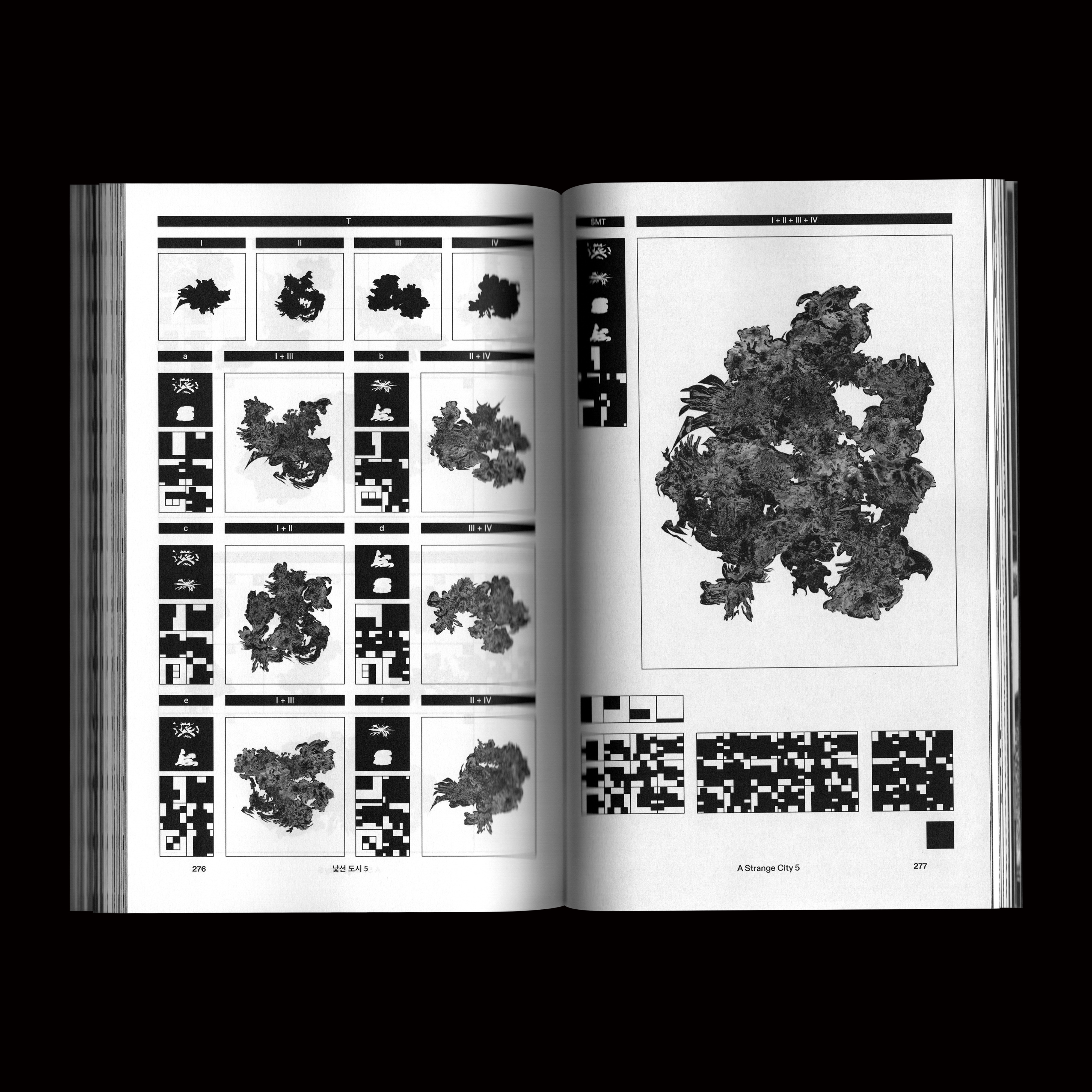
Images︎︎︎
Body (Hansol Lee, Simulta)
HANSOL LEE
Constantly changing anxiety seems to be the basic state of living. I often draw the curve of my life, but at some times it is drawn as a quiet straight line. But when I get closer to that straight line, it curves with the sound of big and small waves. I looked for the form of anxiety in order to at least not be anxious about anxiety itself. It may not be possible to completely flatten the curve, but by knowing the shape, I hope to smooth out the incline.
The anxiety I feel most vividly now is the anxiety when I lose something. It's the anxiety I feel in an empty seat. If I look at each one without being swept away, all kinds of doubts, regrets, expectations, denial, and abandonment were mixed or moving rapidly. It was a sporadic movement to busily find what was lost. To capture this chaotic and constantly moving anxiety, I went through a reconstruction and overlapping phase based on the 'position of gestures (body, hand, foot) to dismantle and find the senses'.

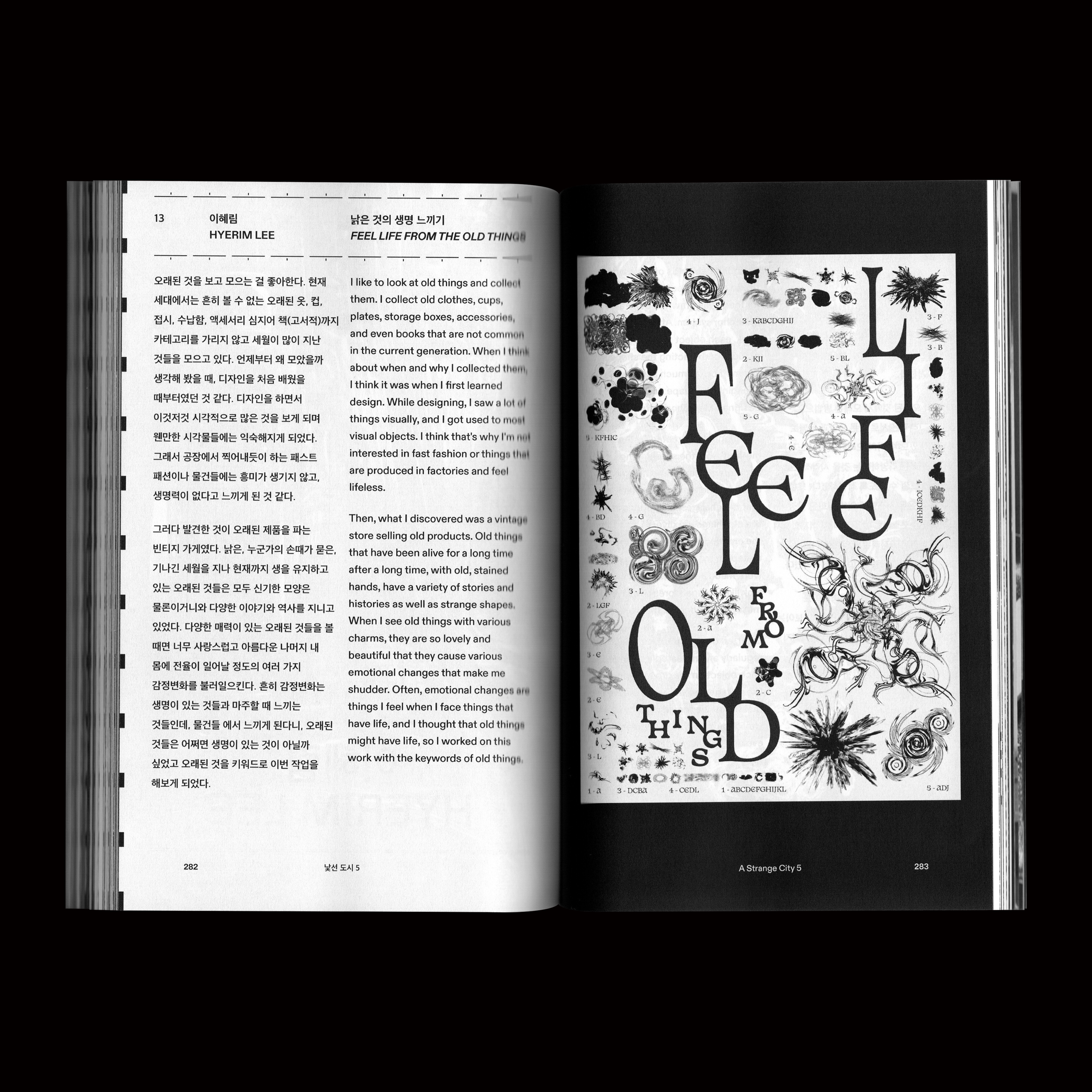
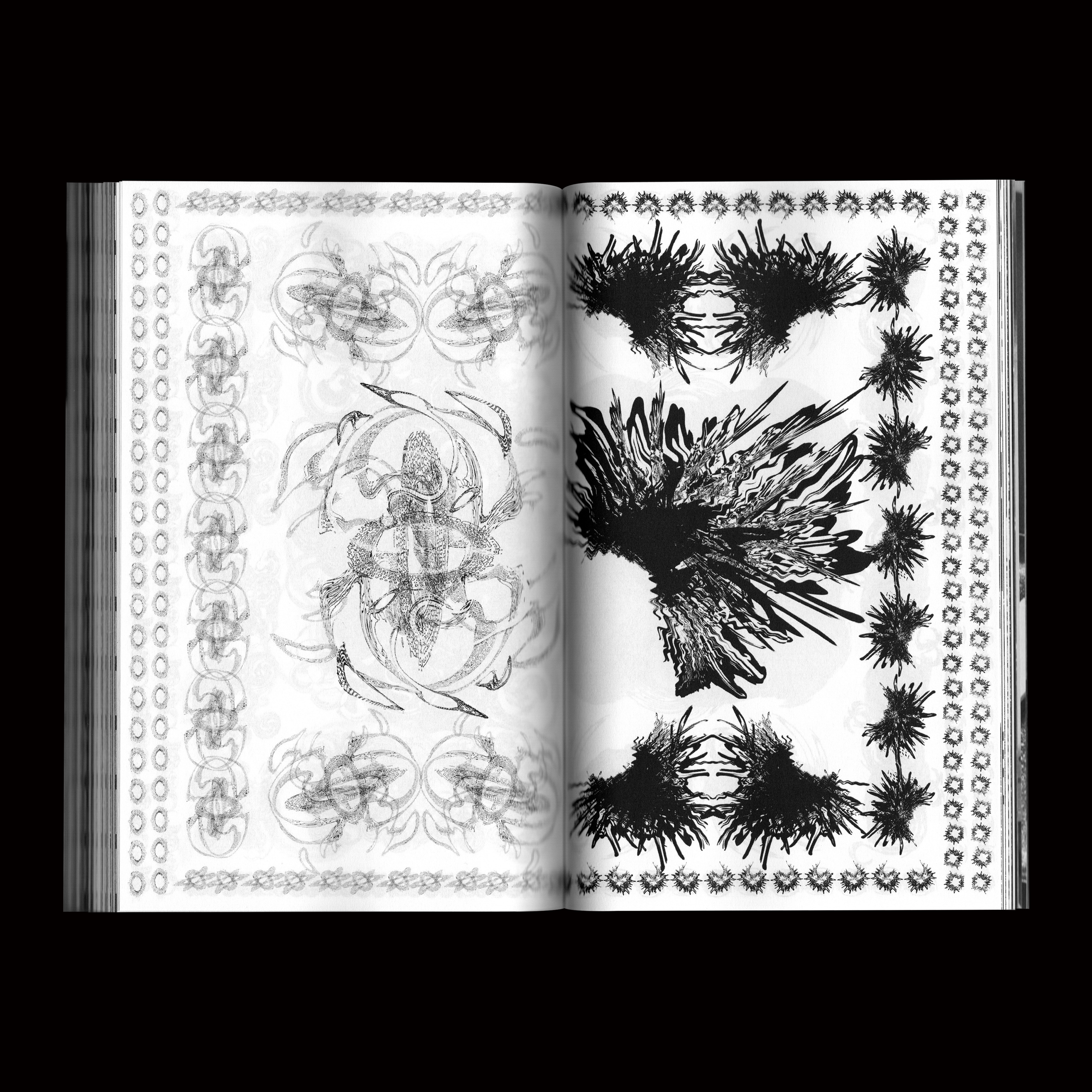
Images︎︎︎
Body (Hyerim Lee, Feel Life From The Old Things)
HYERIM LEE
I like to look at old things and collect them. I collect old clothes, cups, plates, storage boxes, accessories, and even books that are not common in the current generation. When I think about when and why I collected them, I think it was when I first learned design. While designing, I saw a lot of things visually, and I got used to most visual objects. I think that's why I'm not interested in fast fashion or things that are produced in factories and feel lifeless.
Then, what I discovered was a vintage store selling old products. Old things that have been alive for a long time after a long time, with old, stained hands, have a variety of stories and histories as well as strange shapes. When I see old things with various charms, they are so lovely and beautiful that they cause various emotional changes that make me shudder. Often, emotional changes are things I feel when I face things that have life, and I thought that old things might have life, so I worked on this work with the keywords of old things.

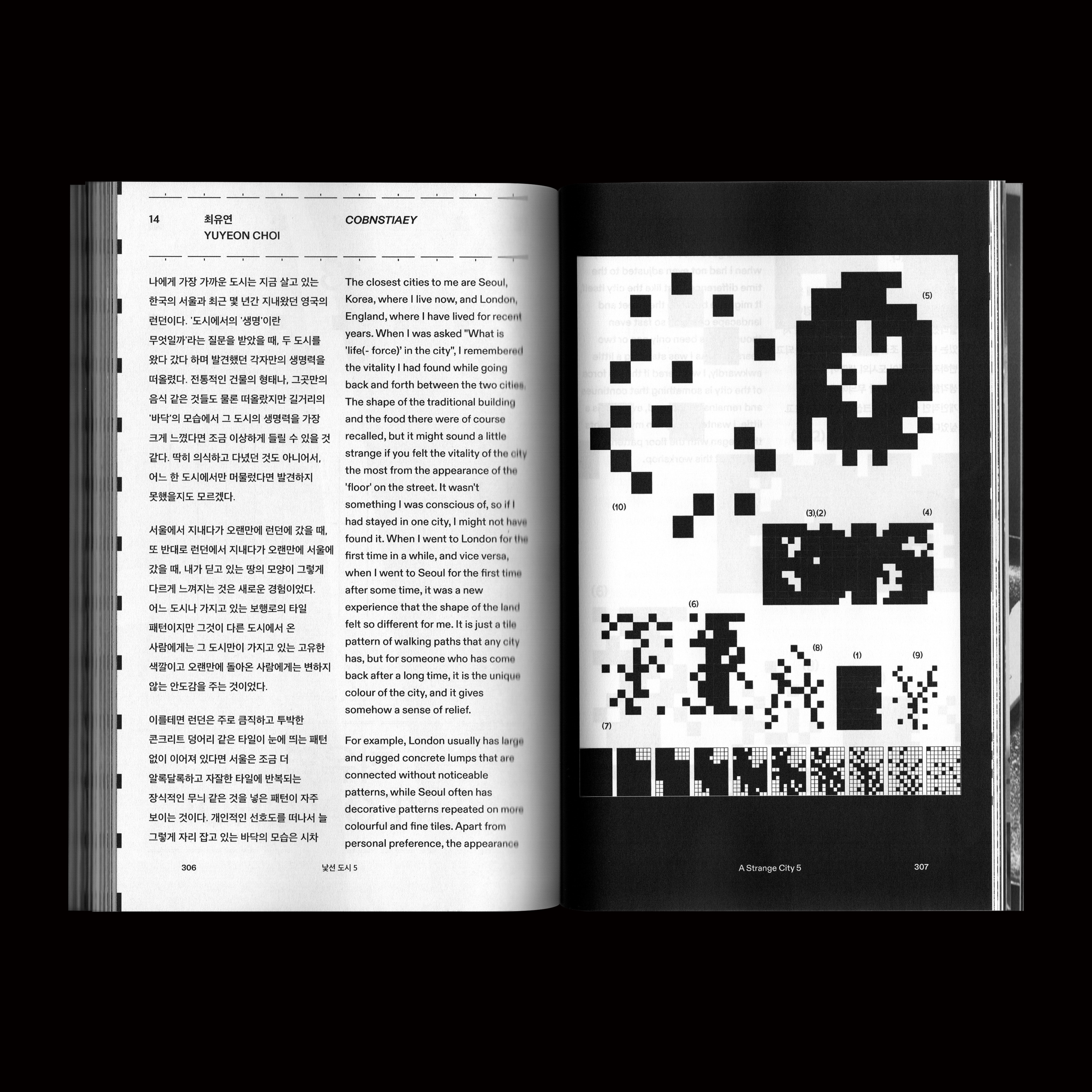

Images︎︎︎
Body (Yuyeon Choi, Cobnstiaey)
YUYEON CHOI
The closest cities to me are Seoul, Korea, where I live now, and London, England, where I have lived for recent years. When I was asked "What is 'life(- force)’ in the city", I remembered the vitality I had found while going back and forth between the two cities. The shape of the traditional building and the food there were of course recalled, but it might sound a little strange if you felt the vitality of the city the most from the appearance of the 'floor' on the street. It wasn't something I was conscious of, so if I had stayed in one city, I might not have found it. When I went to London for the first time in a while, and vice versa, when I went to Seoul for the first time after some time, it was a new experience that the shape of the land felt so different for me. It is just a tile pattern of walking paths that any city has, but for someone who has come back after a long time, it is the unique colour of the city, and it gives somehow a sense of relief.
For example, London usually has large and rugged concrete lumps that are connected without noticeable patterns, while Seoul often has decorative patterns repeated on more colourful and fine tiles. Apart from personal preference, the appearance of the floor, which is always in the same place, reminded me of where I am and gave me a sense of stability when I had not even adjusted to the time difference. Just like the city itself, It might be because the street and landscape changed so fast even though it has been only one or two years past. As I was standing a little awkwardly, I wondered if the life force of the city is something that continues and remains unchanged, even if it is a little. I wanted to explain my thoughts that began with the floor patterns of the city at this workshop.